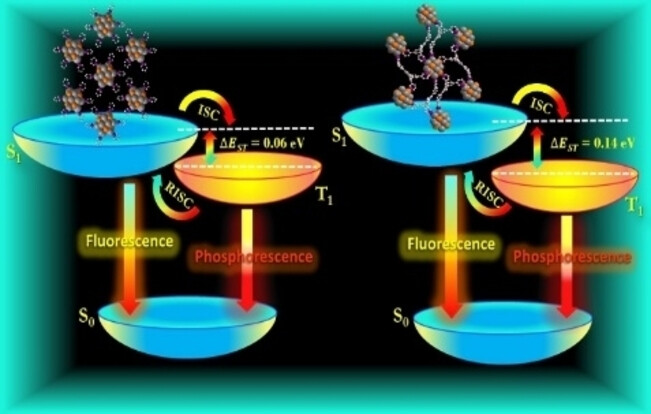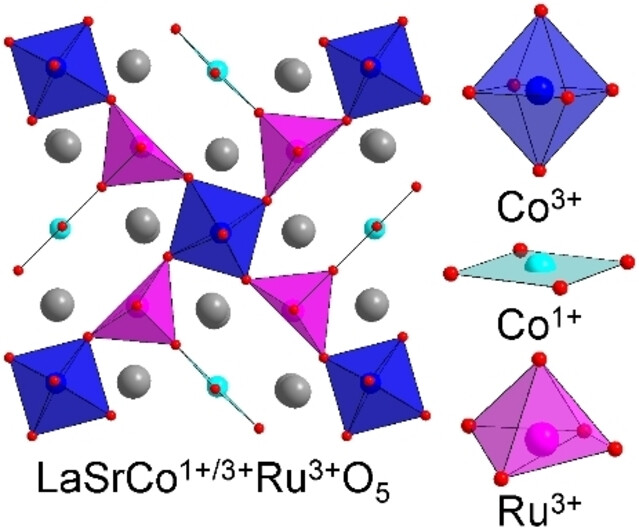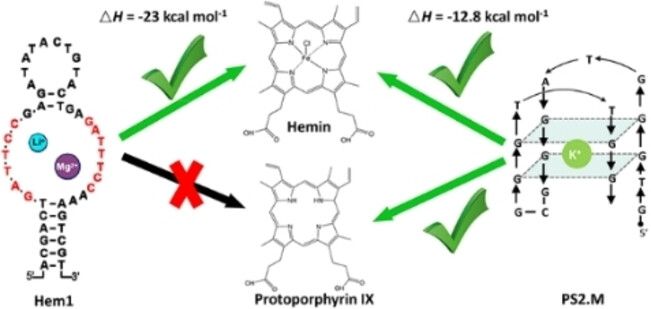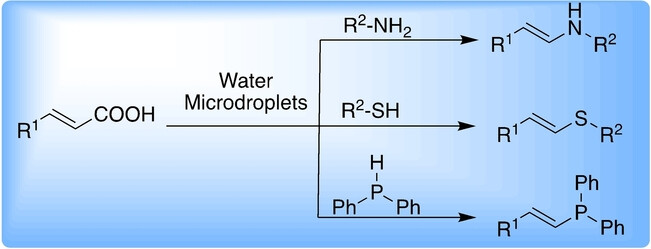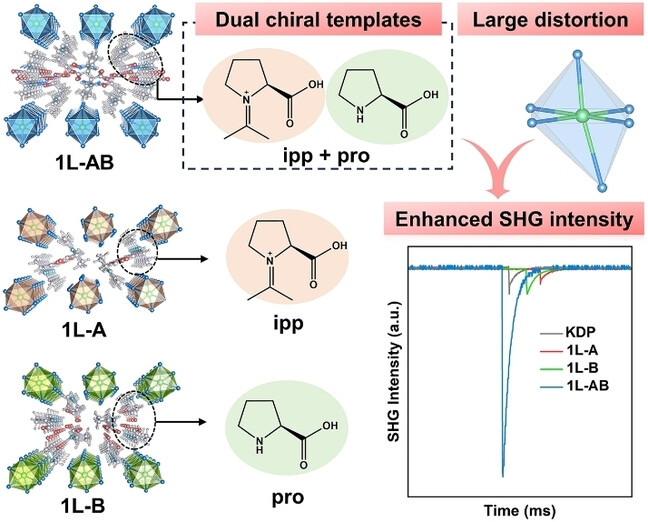Journal list menu
Export Citations
Download PDFs
Covers
Cover Picture: Real-Time Live Imaging of Osteoclast Activation via Cathepsin K Activity in Bone Diseases (Angew. Chem. Int. Ed. 6/2024)
- First Published: 18 January 2024
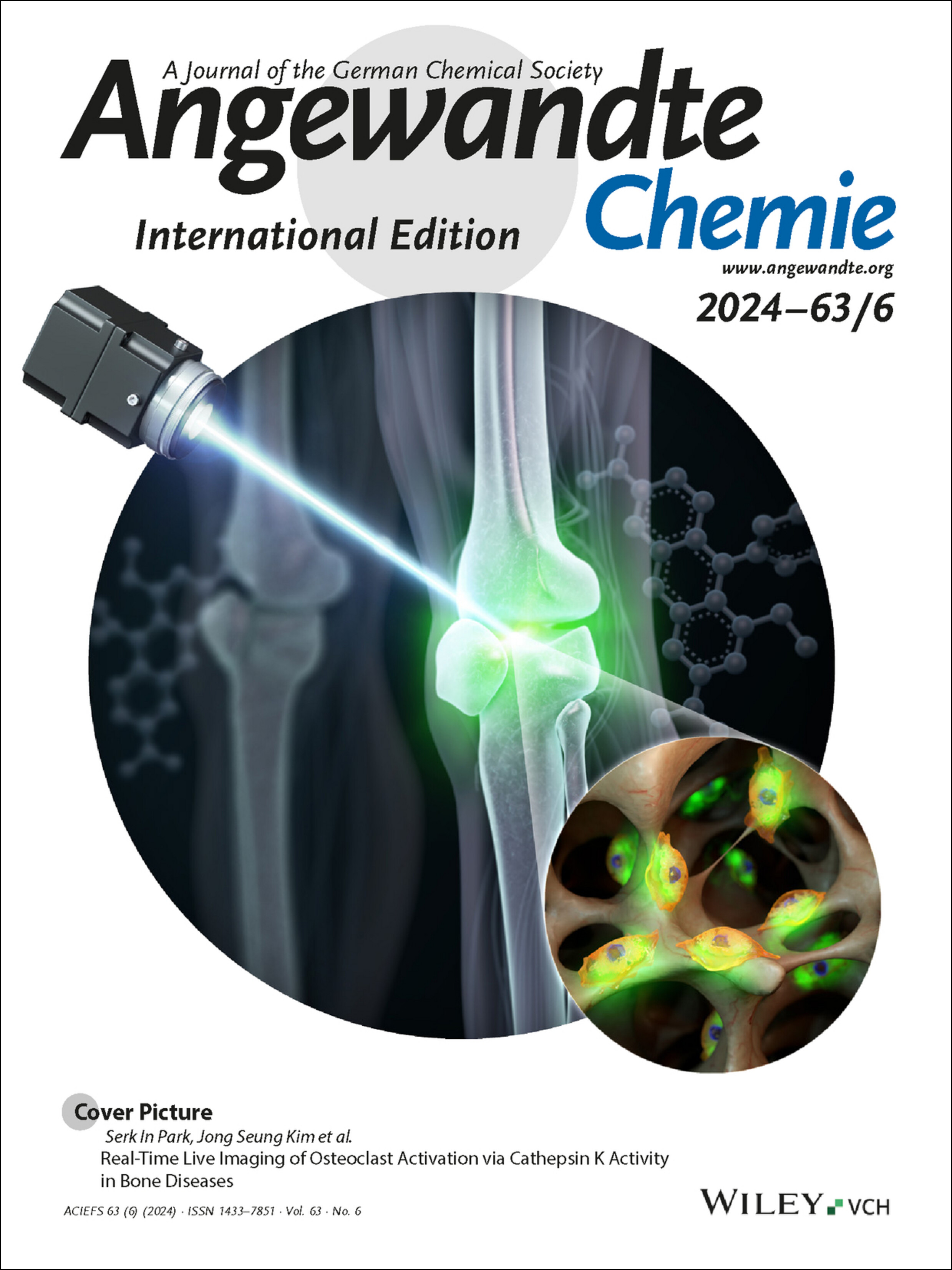
A novel fluorogenic probe for imaging osteoclasts, the major culprit in pathologic bone destruction, is unveiled by Jong Seung Kim, Serk In Park et al. in their Research Article (e202318459). This probe shows enhanced physicochemical properties for real-time intravital deep-tissue imaging of osteoclasts in the long bones of various mouse models, facilitating the development of therapeutic strategies. The discovery marks a significant advance in molecular imaging, opening new avenues in osteoclast-related bone disease research and drug discoveries.
Inside Cover: Understanding the Role of Trapezoids in Honeycomb Self-Assembly—Pathways between a Columnar Liquid Quasicrystal and its Liquid-Crystalline Approximants (Angew. Chem. Int. Ed. 6/2024)
- First Published: 27 December 2023
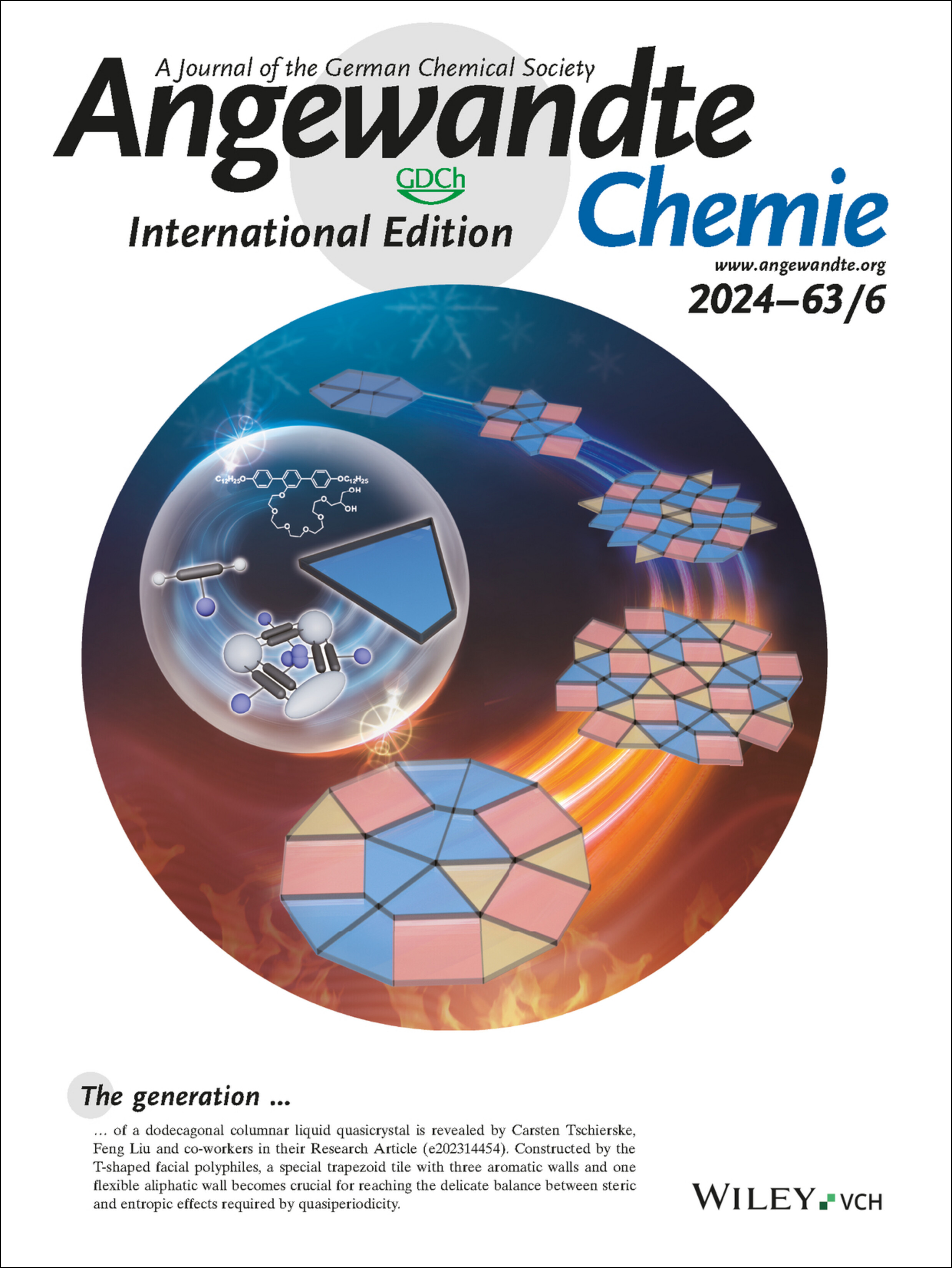
The generation of a dodecagonal columnar liquid quasicrystal is revealed by Carsten Tschierske, Feng Liu and co-workers in their Research Article (e202314454). Constructed by the T-shaped facial polyphiles, a special trapezoid tile with three aromatic walls and one flexible aliphatic wall becomes crucial for reaching the delicate balance between steric and entropic effects required by quasiperiodicity.
Inside Back Cover: Assembly of Luminescent Chiral Gold(I)-Sulfido Clusters via Chiral Self-Sorting (Angew. Chem. Int. Ed. 6/2024)
- First Published: 03 January 2024
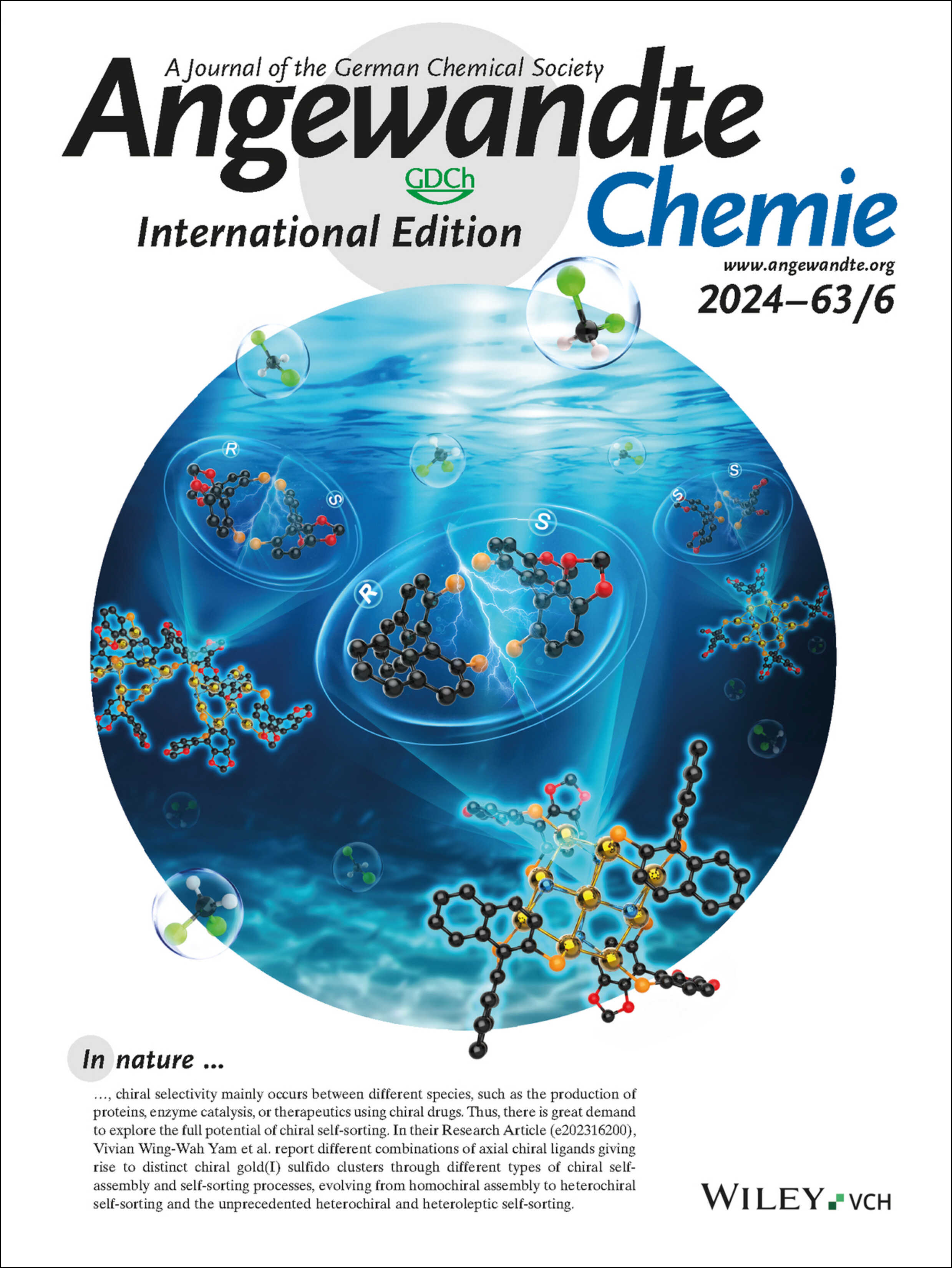
In nature, chiral selectivity mainly occurs between different species, such as the production of proteins, enzyme catalysis, or therapeutics using chiral drugs. Thus, there is great demand to explore the full potential of chiral self-sorting. In their Research Article (e202316200), Vivian Wing-Wah Yam et al. report different combinations of axial chiral ligands giving rise to distinct chiral gold(I) sulfido clusters through different types of chiral self-assembly and self-sorting processes, evolving from homochiral assembly to heterochiral self-sorting and the unprecedented heterochiral and heteroleptic self-sorting.
Back Cover: Exchangeable Self-Assembled Lanthanide Antennas for PLIM Microscopy (Angew. Chem. Int. Ed. 6/2024)
- First Published: 27 December 2023
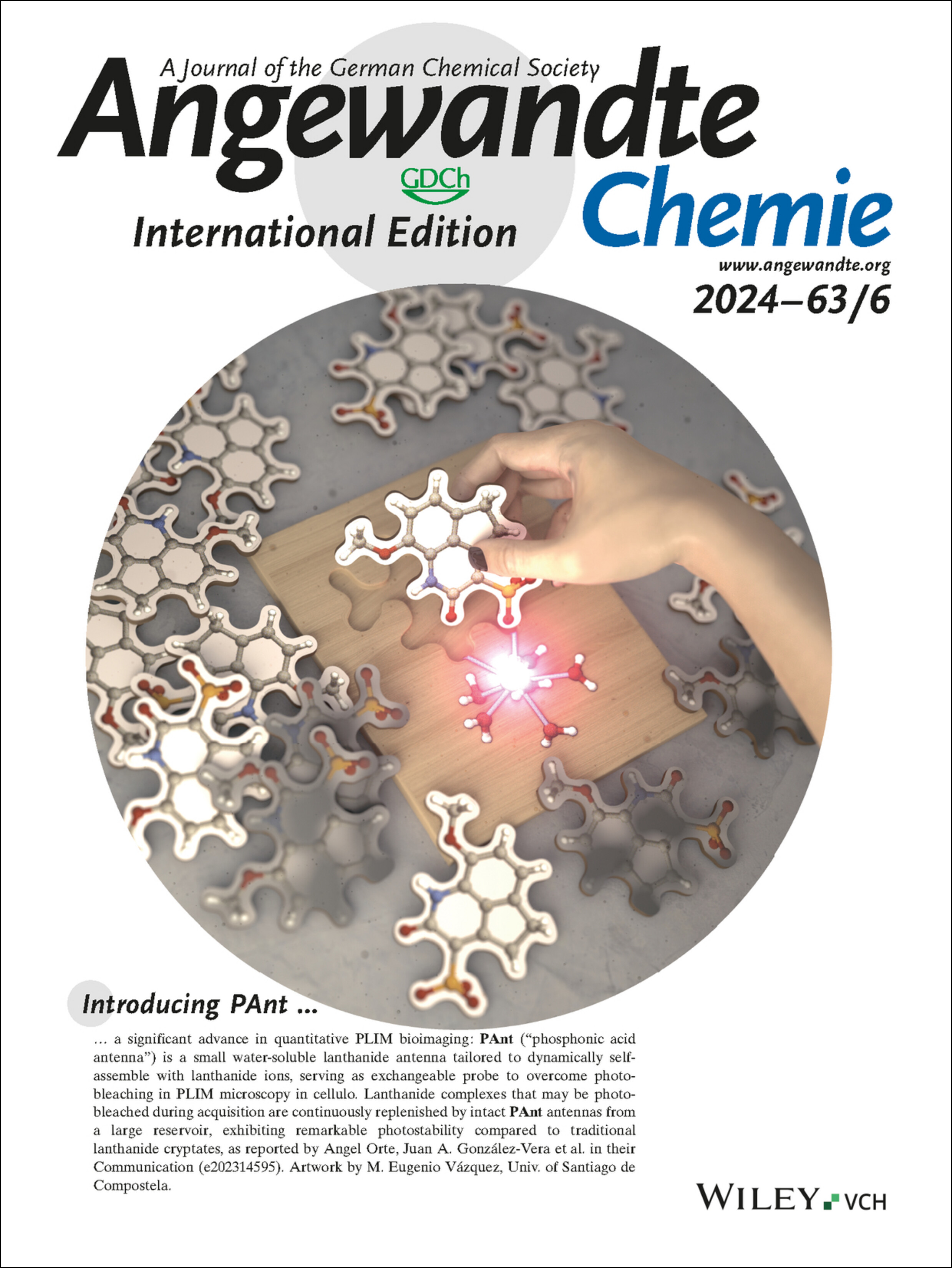
Introducing PAnt a significant advance in quantitative PLIM bioimaging: PAnt (“phosphonic acid antenna”) is a small water-soluble lanthanide antenna tailored to dynamically self-assemble with lanthanide ions, serving as exchangeable probe to overcome photobleaching in PLIM microscopy in cellulo. Lanthanide complexes that may be photobleached during acquisition are continuously replenished by intact PAnt antennas from a large reservoir, exhibiting remarkable photostability compared to traditional lanthanide cryptates, as reported by Angel Orte, Juan A. González-Vera et al. in their Communication (e202314595). Artwork by M. Eugenio Vázquez, Univ. of Santiago de Compostela.
Frontispiece
Frontispiece: Shearing Liquid-Crystalline MXene into Lamellar Membranes with Super-Aligned Nanochannels for Ion Sieving
- First Published: 31 January 2024
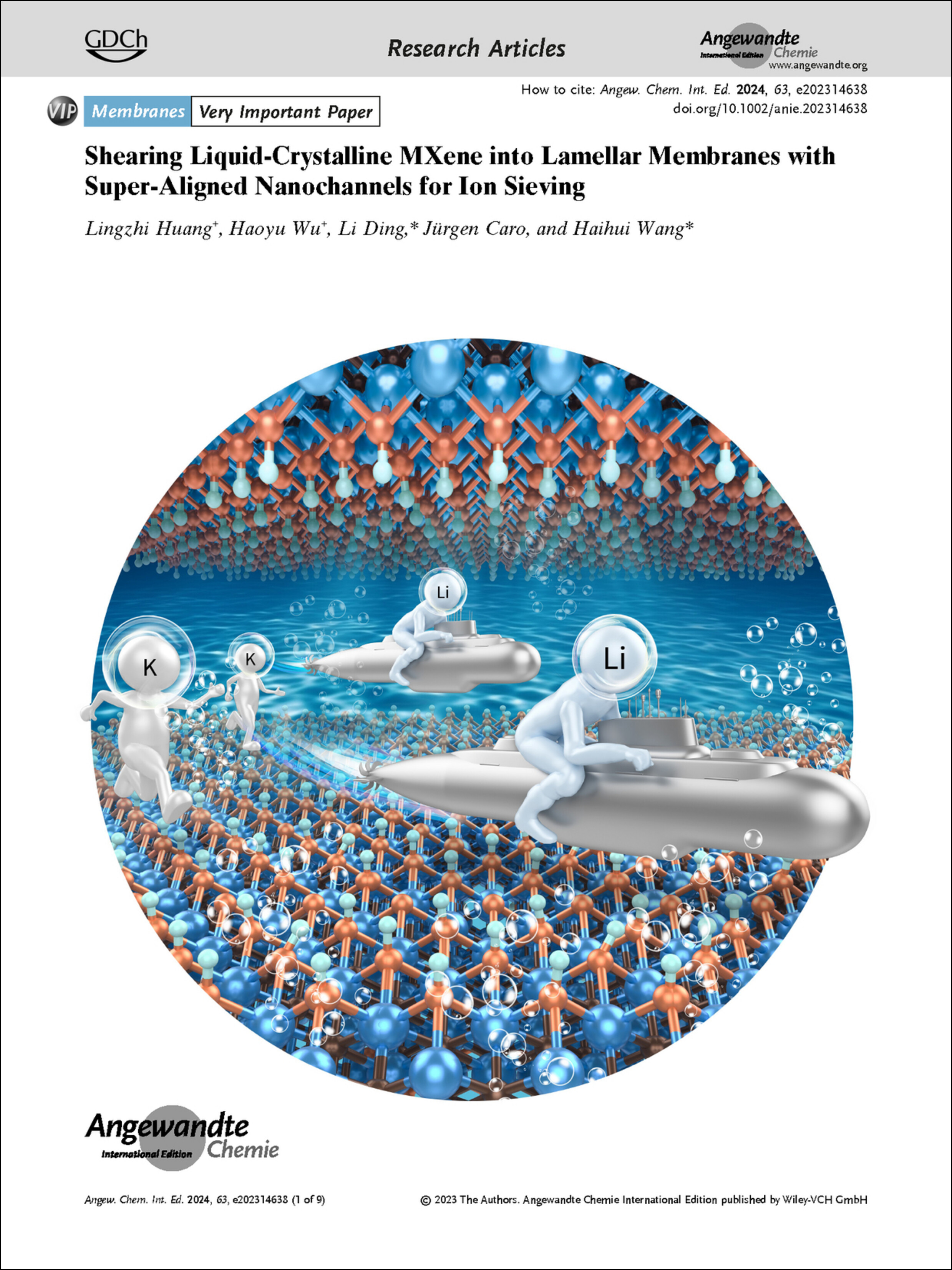
MXenes. In their Research Article (e202314638), Li Ding, Jürgen Caro, Haihui Wang et al. report a 2D MXene membrane with super-aligned nanochannels by applying shear forces to a liquid-crystalline MXene nanosheet dispersion.
Graphical Abstract
Introducing …
Minireviews
Fluorescent Probes
Molecular Rotors: Fluorescent Sensors for Microviscosity and Conformation of Biomolecules
- First Published: 19 October 2023

In this review, we describe recent advances in the development of fluorescence-based viscosity sensors, termed Molecular Rotors, and discuss how these dyes can be exploited to quantify the microviscosity of biological environment, probe lipid membranes and non-canonical nucleic acid architectures and track dynamic processes, including protein aggregation.
Bioimaging
Polymers
Precision Sequence-Defined Polymers: From Sequencing to Biological Functions
- First Published: 24 October 2023
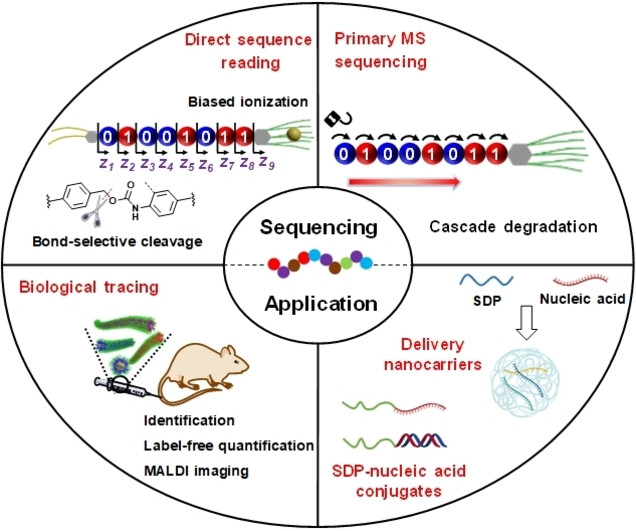
This Minireview summarizes recent advances in sequence-defined synthetic polymers (SDPs), focusing on newly developed sequencing methods including tandem mass spectrometry (MS) based on bond-selective cleavage and biased ionization, and primary MS based on cascade degradation. Their biological functions are also highlighted, and future perspectives of SDPs outlined.
Reviews
Polymerization Catalysis
Visualizing the Structure, Composition and Activity of Single Catalyst Particles for Olefin Polymerization and Polyolefin Decomposition
- First Published: 02 October 2023
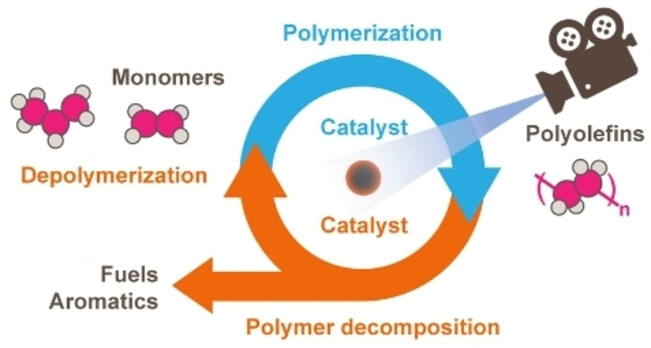
A variety of laboratory- and synchrotron-based chemical imaging techniques can be employed to study heterogeneous catalysts at high spatial and temporal resolutions. This review discusses related advances in the fields of olefin polymerization and polyolefin decomposition catalysis and highlights future research directions that can ultimately deliver more detailed insights into structure-performance relationships in relevant catalyst materials.
Bioimaging
Research Articles
Membranes | Very Important Paper
Shearing Liquid-Crystalline MXene into Lamellar Membranes with Super-Aligned Nanochannels for Ion Sieving
- First Published: 27 November 2023

This work reports a two-dimensional (2D) MXene membrane with super-aligned nanochannels by applying shear forces to liquid-crystalline (LC) MXene nanosheet dispersion. The as-prepared LC MXene membrane (LCMM) shows excellent in-plane stacking order and precise interlayer spacing of ≈6 Å, demonstrating ultrahigh selectivities toward Li+/Na+, Li+/K+, and Li+/Rb+ (≈45, ≈49, and ≈59, respectively), outperforming the state-of-the-art membranes.
Bioelectrochemistry | Hot Paper
Cable Bacteria Skeletons as Catalytically Active Electrodes
- First Published: 29 November 2023

Biological cables as electrodes: Electrically conducting filamentous cable bacteria skeletons were used as free-standing biological electrodes and displayed catalytic selectivity towards oxygen. The skeletons convert water to oxygen and oxygen back to water. We show that the reactions can be driven either by an external electric field or by simply exposing the cables to a gradient of oxygen concentration.
Enzyme Catalysis
The Diterpenoid Substrate Analogue 19-nor-GGPP Reveals Pronounced Methyl Group Effects in Diterpene Cyclisations
- First Published: 20 December 2023
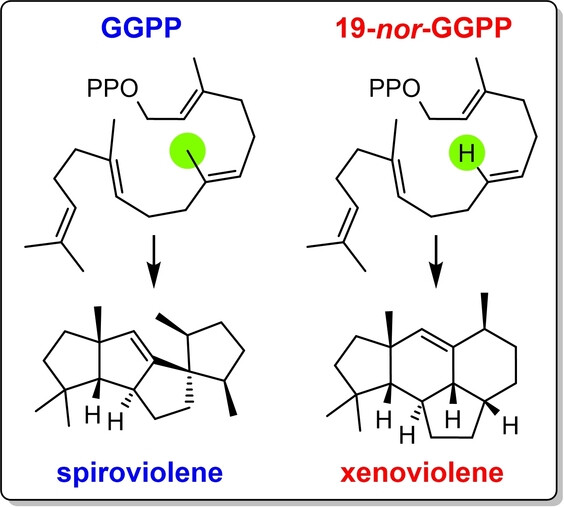
19-nor-Geranylgeranyldiphosphate (with a methyl group removed) has been synthesised and converted into diterpene analogues with 20 diterpene synthases. In some cases only the desmethyl derivatives of the natural enzyme products were obtained, but with several enzymes a dramatic change in the reactivity was observed. The newly opened reaction paths to compounds with unknown skeletons reveal an intriguing methyl group effect in diterpene biosynthesis.
Lithium Batteries
Asymmetric Solvents Regulated Crystallization-Limited Electrolytes for All-Climate Lithium Metal Batteries
- First Published: 15 December 2023
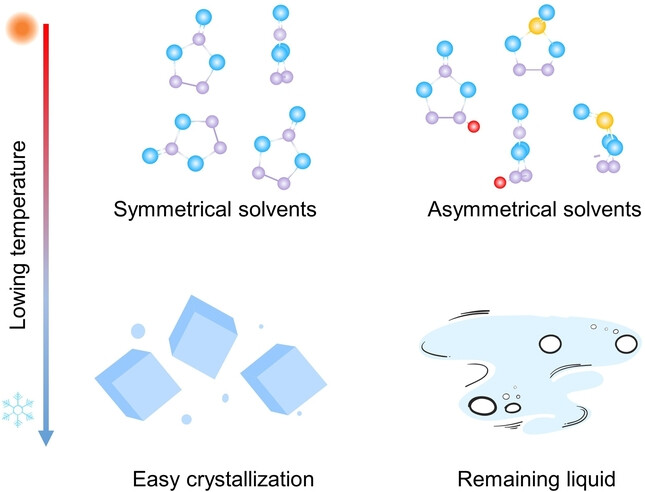
A novel asymmetric solvents regulated crystallization limitation strategy is developed to lower electrolyte operation temperature windows for lithium metal batteries. Mixing asymmetric ethylene sulfite (ES) and fluoroethylene carbonate (FEC) can reduce the molecular interaction and orientation arrangement dynamics, allowing the resulting electrolyte to show fast ion transport even at −50 °C.
Systems Chemistry
Self-Propelling Macroscale Sheets Powered by Enzyme Pumps
- First Published: 11 December 2023
Catalysis
Reference-Quality Free Energy Barriers in Catalysis from Machine Learning Thermodynamic Perturbation Theory
- First Published: 06 December 2023
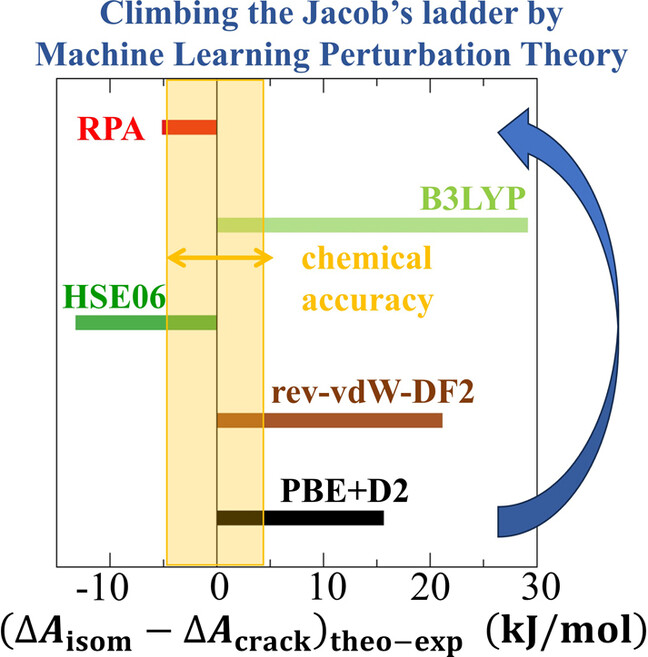
Free energy barriers of acid-catalyzed cracking and isomerization reactions of alkenes are computed at an unprecedented level of theory, combining dynamic effects investigated by ab initio molecular dynamics and high-level electronic energy calculations with Machine Learning thermodynamic Perturbation Theory. The results are close to chemical accuracy.
Organic Electronics
Azonia-Naphthalene: A Cationic Hydrophilic Building Block for Stable N-Type Organic Mixed Ionic-Electronic Conductors
- First Published: 08 November 2023
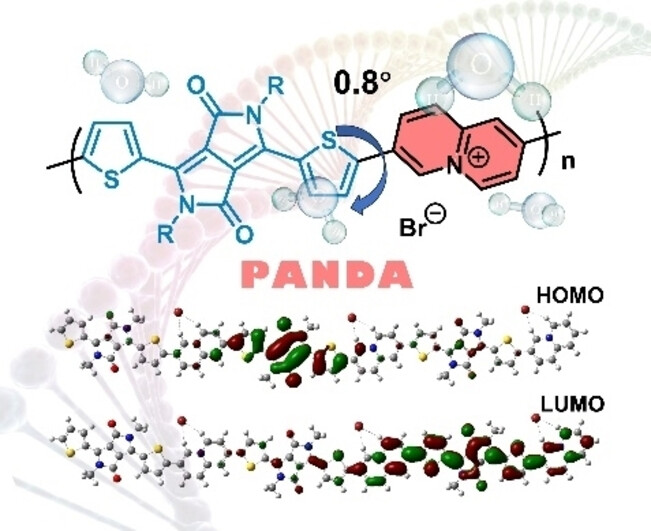
We develop a novel hydrophobic building block, 4a-azonia-naphthalene (AN), for n-type organic mixed ionic-electronic conductors. AN have the strong electron-withdrawing ability, and exhibit strong cation-π interactions, leading to smaller π–π stacking distance, interesting ion diffusion behavior, and good morphology stability, resulting in improved ion diffusion/injection speed and operational stability of organic electrochemical transistors.
Analytical Methods | Hot Paper
A Magnetic Resonance Imaging-Chemical Exchange Saturation Transfer (MRI-CEST) Method for the Detection of Water Cycling across Cellular Membranes
- First Published: 31 October 2023
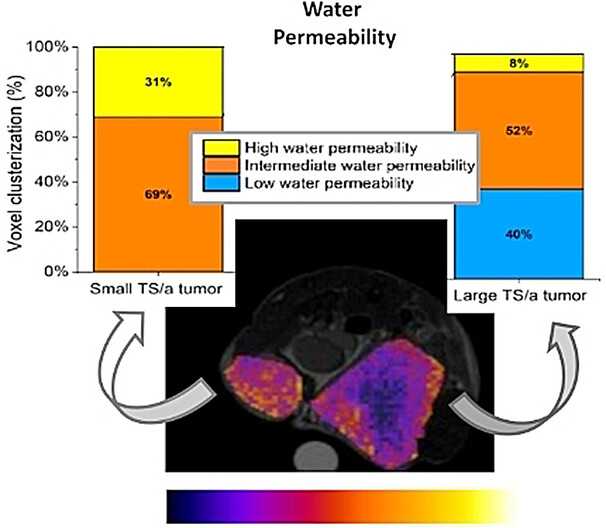
A Magnetic Resonance Imaging-Chemical Exchange Saturation Transfer (MRI-CEST) method to image and quantify in vivo water cycling across cell membranes is reported. Parametric MRI-maps can be obtained that report, for each voxel, the degree of water permeability across cells. Cell membrane water permeability is a biomarker of cancer aggressiveness and can be used to monitor chemotherapy, as demonstrated in murine models of breast cancers.
CO2 Conversion | Hot Paper
Selective CO2-to-Syngas Conversion Enabled by Bimetallic Gold/Zinc Sites in Partially Reduced Gold/Zinc Oxide Arrays
- First Published: 18 October 2023
Natural Products
Discovery of Natural Potent HMG-CoA Reductase Degraders for Lowering Cholesterol
- First Published: 06 December 2023
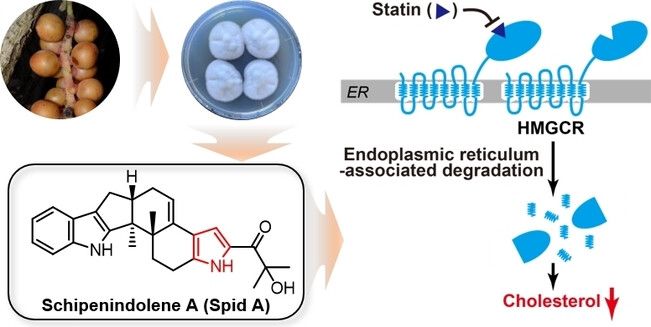
The plant Schisandra macrocarpa was explored for the extraction of novel compounds from its fungal endophyte Penicillium sp. DG23. Of the indole diterpenoids and derivatives identified, biological evaluation highlighted schipenindolene A as a potent HMGCR degrader that further lowered cholesterol with statin (HMGCR inhibitor) by activating the endoplasmic reticulum-associated degradation pathway and inhibiting the compensatory effects of statin.
Heterogeneous Catalysis | Hot Paper
Post-Synthetic Ensembling Design of Hierarchically Ordered FAU-type Zeolite Frameworks for Vacuum Gas Oil Hydrocracking
- First Published: 16 October 2023

Novel post-synthetic ensembling design comprising methodical incision of conventional FAU-type zeolites into unit-cell level zeolitic fragments and their subsequent reorganization into hierarchically ordered zeolites exhibiting 2D-hexagonal/3D-cubic mesopore channels. This approach eludes the kinetic constraints of conventional crystallization to produce hierarchical zeolites having excellent catalytic properties in hydrocracking applications.
Amination
Werner Salt as Nickel and Ammonia Source for Photochemical Synthesis of Primary Aryl Amines
- First Published: 01 November 2023
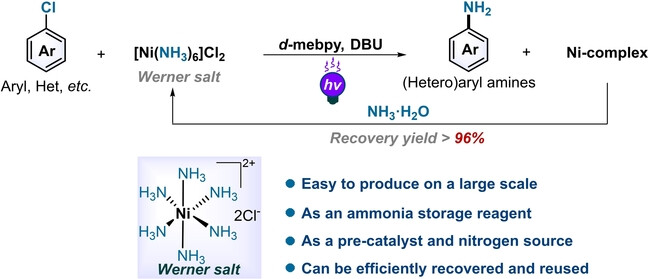
The Werner salt [Ni(NH3)6]Cl2 can be used as both a nitrogen and a catalytic nickel source that allow for the efficient amination of aryl chlorides in the presence of a catalytic amount of bipyridine ligand under the irradiation of 390–395 nm light without the need of any additional catalysts, solving the problem of easy deactivation and difficult recovery of transition metal nickel catalysts.
Theoretical Chemistry
Confined Lewis Pairs: Investigation of the X−→Si20 Interaction in Halogen-Encapsulating Silafulleranes
- First Published: 07 December 2023
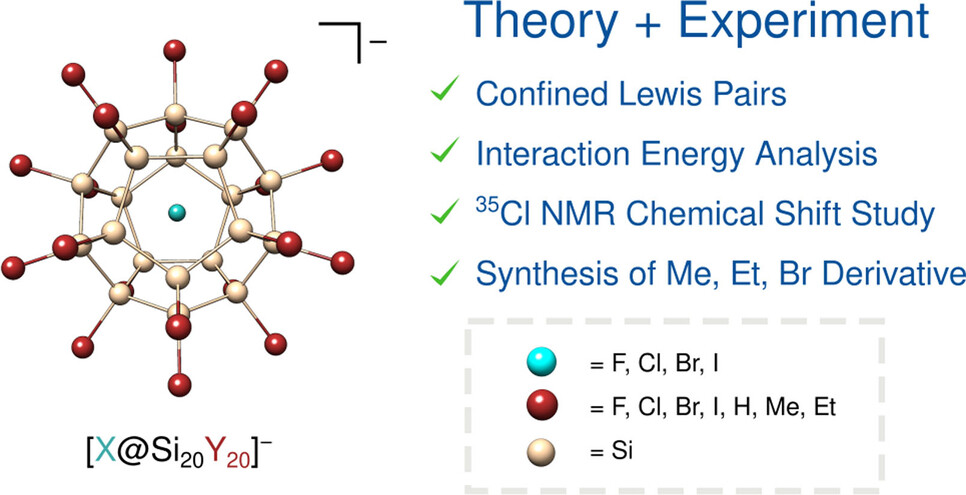
A joint theoretical and experimental study on 32 endohedral silafulleranes is presented. Template effects of Cl− are investigated for the [X@Si20Y20]− complexes that are classified as “confined Lewis pairs”. The origins of the diagnostic 35Cl NMR chemical shifts are elucidated computationally. Finally, we disclose the synthesis of [PPN][Cl@Si20Y20] (Y=Me, Et, Br) including their thorough characterization.
Liquid Crystals | Hot Paper
Understanding the Role of Trapezoids in Honeycomb Self-Assembly—Pathways between a Columnar Liquid Quasicrystal and its Liquid-Crystalline Approximants
- First Published: 27 November 2023
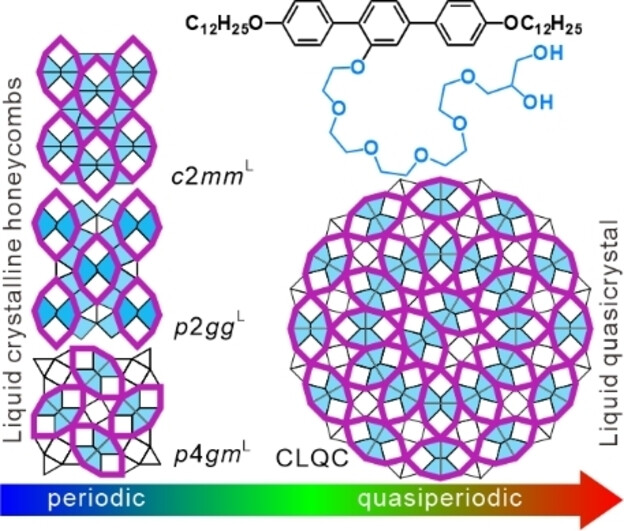
T-shaped polyphiles self-assemble into a liquid quasicrystal and a series of liquid-crystalline periodic approximants, all representing polygonal honeycombs formed by the stacking of p-terphenyls. Featuring giant octagonal motifs containing non-regular trapezoidal or pentagonal with regular triangular and square tiles, the phases assume a transition of motif orientation, triggered by the changing conformation and entropy of the alkyl end chains.
Hydrogels | Hot Paper
Dynamic Exchange in 3D Cell Culture Hydrogels Based on Crosslinking of Cyclic Thiosulfinates
- First Published: 06 December 2023

Cyclic thiosulfinates can generate disulfide-crosslinked dynamic covalent hydrogels without additional stimuli to gain control over stress relaxation based on thiol content and mode of crosslinker application. Pluripotent stem cell-derived cardiomyocytes can be 3D cultured in hydrogels containing macromonomers with this chemistry, displaying native behaviours, such as cell spreading and spontaneous beating.
Asymmetric Catalysis
Reversal of Regioselectivity in Asymmetric C−H Bond Annulation with Bromoalkynes under Cobalt Catalysis
- First Published: 14 December 2023

Herein, we demonstrate the cobalt-catalyzed asymmetric desymmetrization of phosphinamides with haloalkynes with excellent enantioinduction and inverse regioselectivity. In a single step, the approach provides access to several P-chiral molecules. Based on control experiments and preliminary study, a plausible mechanism is provided.
Cancer Therapy
Polyoxometalate-Nanozyme-Integrated Nanomotors (POMotors) for Self-Propulsion-Promoted Synergistic Photothermal-Catalytic Tumor Therapy
- First Published: 20 December 2023
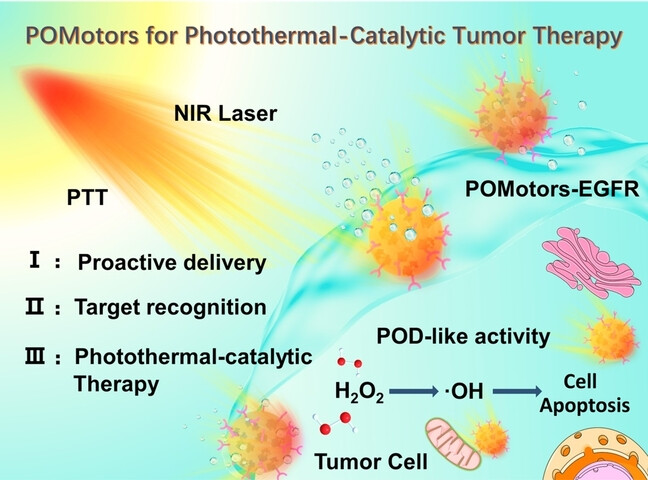
Polyoxometalate nanozyme-integrated polydopamine-conjugated nanomotors (POMotors) were constructed. They show peroxidase-like catalytic activity and NIR-triggered photothermal properties, therefore exhibiting enzyme-powered enhanced Brownian motion and NIR-triggered self-propulsion. Based on these properties of POMotors, a highly efficient self-propulsion-enhanced photothermal-catalytic synergistic tumor therapy was achieved.
Metal-Organic Frameworks | Very Important Paper
Zr-Porphyrin Metal–Organic Framework as nanoreactor for boosting the formation of hydrogen clathrates
- First Published: 13 December 2023
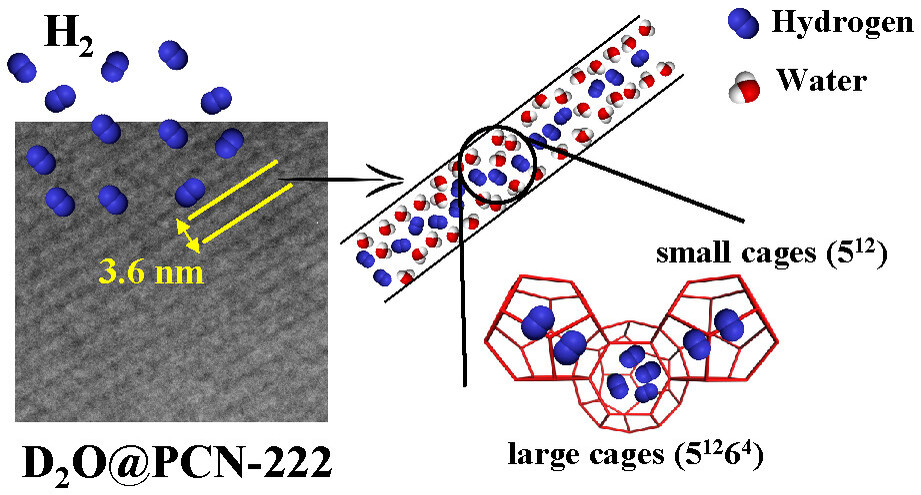
Microwave-assisted PCN-222 nanocrystals has been successfully used as nanoreactors to promote the nucleation and growth of hydrogen clathrates. This research shows that hydrogen can be enclathrated at lower pressure than the bulk system, with fast kinetics and with a nearly complete water-to-hydrate conversion.
Proteomics | Hot Paper
A Systematic Investigation of Proteoforms with N-Terminal Glycine and Their Dynamics Reveals Its Impacts on Protein Stability
- First Published: 20 December 2023
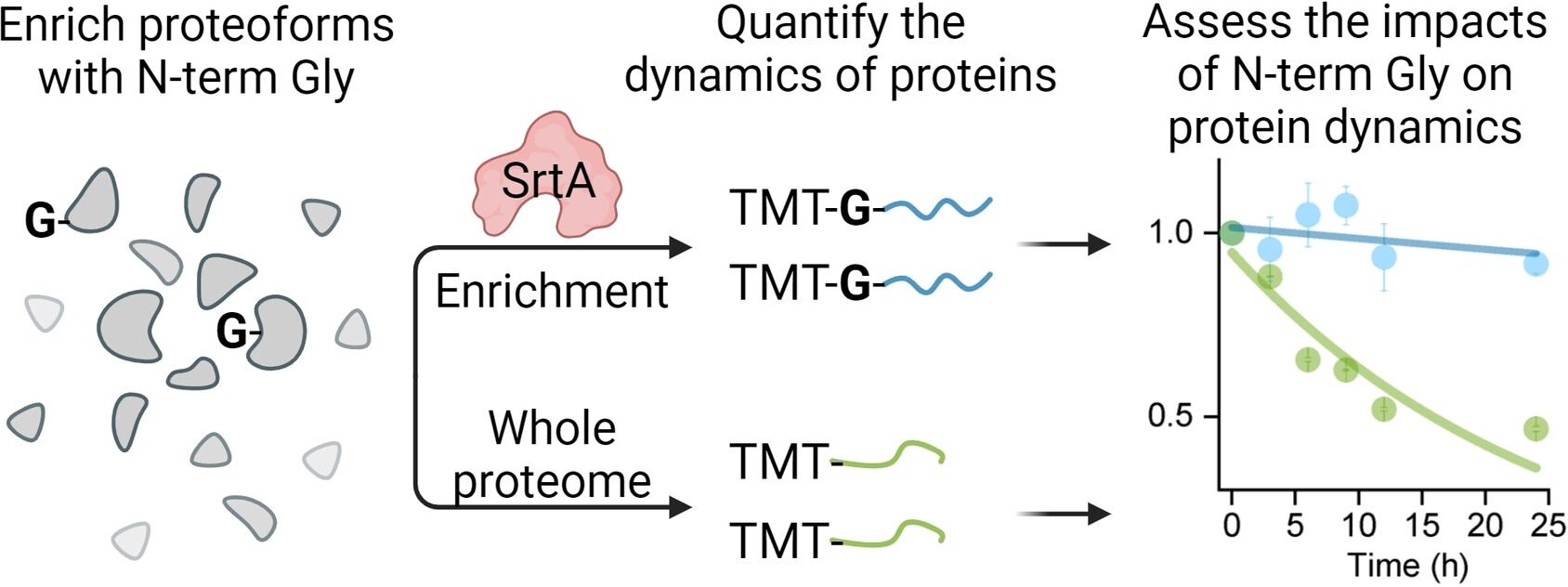
A chemoenzymatic method based on sortase A catalyzed ligation was developed to characterize proteoforms with N-terminal glycine in human cells and quantify their dynamics. Around 2000 proteoforms with N-terminal glycine were identified, and most of them were previously unknown. Bioinformatic analyses reveal proteoforms with N-terminal glycine with the fastest and slowest degradation rates have different functions and localizations.
Synthetic Methods
Photoredox-Catalyzed α−C−H Monoalkylation of Symmetric Polyols in the Presence of CO2
- First Published: 13 December 2023
Helical Structures
A Metal-Free Helical Covalent Inorganic Polymer: Preparation, Crystal Structure and Optical Properties
- First Published: 21 December 2023
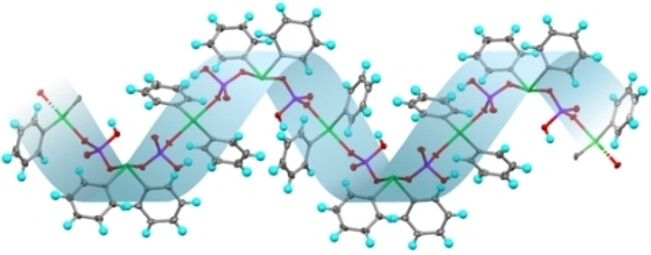
A metal-free helical covalent inorganic polymer (CityU-10) has been successfully prepared. Its crystal structure shows that the same-handed helical chains form a pseudo-two-dimensional layer via multiple hydrogen-bonding interactions. Then, the left-handed layers and right-handed layers alternatively stack together to form a three-dimensional supramolecular structure.
Lithium-Ion Batteries | Very Important Paper
Probing Degradation in Lithium Ion Batteries with On-Chip Electrochemistry Mass Spectrometry
- First Published: 16 December 2023
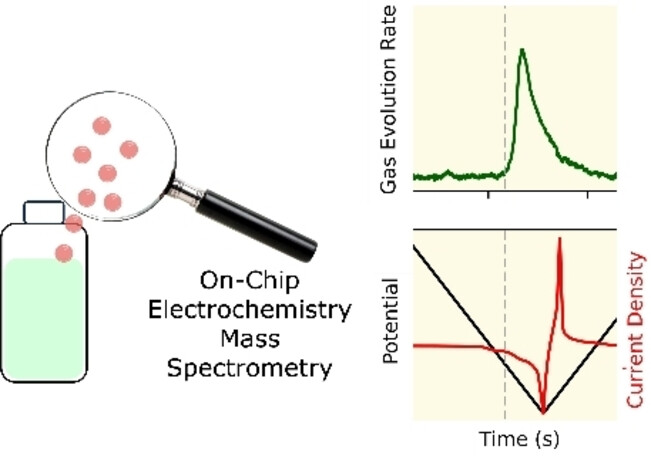
In batteries, the formation of gases such as oxygen, carbon dioxide and ethylene accompanies degradation. Ultrasensitive on chip electrochemistry mass spectrometry reveals previously undetectable gas evolution in lithium ion batteries. The ensuing insight will enable battery scientists to predict degradation mechanisms and discover new strategies to stabilise device performance.
Ion Pairing | Hot Paper
Counterion Effect in Cobaltate-Catalyzed Alkene Hydrogenation
- First Published: 07 December 2023

The counterion makes a difference in alkene hydrogenations promoted by low-valence cobaltate salts. The best performing catalyst cleanly hydrogenated various alkenes (including tri- and tetra-substituted) under mild conditions. Mechanistic studies point toward a homotopic catalyst and show how counterion coordination to hydride intermediates modulates the barrier for the turnover-limiting migratory insertion.
Solar Cells
Precise Methylation Yields Acceptor with Hydrogen-Bonding Network for High-Efficiency and Thermally Stable Polymer Solar Cells
- First Published: 15 December 2023

We developed four small-molecule acceptors (Qo1, Qo2, Qo3 and Qo4) by incorporating a methylation strategy. Solar cells fabricated with polymer donor PM6 and Qo2 realized the highest power conversion efficiency of 18.4 %, surpassing the efficiencies of devices based on Qo1 (15.8 %), Qo3 (16.7 %), and Qo4 (2.4 %).
Anion Sensing
Anion Sensing through Redox-Modulated Fluorescent Halogen Bonding and Hydrogen Bonding Hosts
- First Published: 08 December 2023
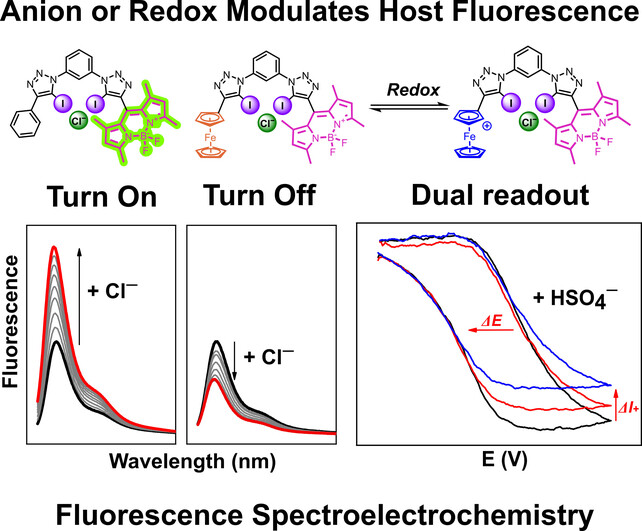
Fluorescence-spectroelectrochemical anion sensing is introduced as a powerful method to enable anion detection via simultaneous emission and voltammetry readouts. The combined advantages of both approaches facilitate anion sensing at very low sensor concentrations and in a competitive solvent system using a redox-active ferrocene-containing BODIPY anion receptor, wherein photoinduced electron transfer (PET) modulates fluorescence emission.
Glyoxal Ammonolysis
Gold Clusters
Assembly of Luminescent Chiral Gold(I)-Sulfido Clusters via Chiral Self-Sorting
- First Published: 27 November 2023
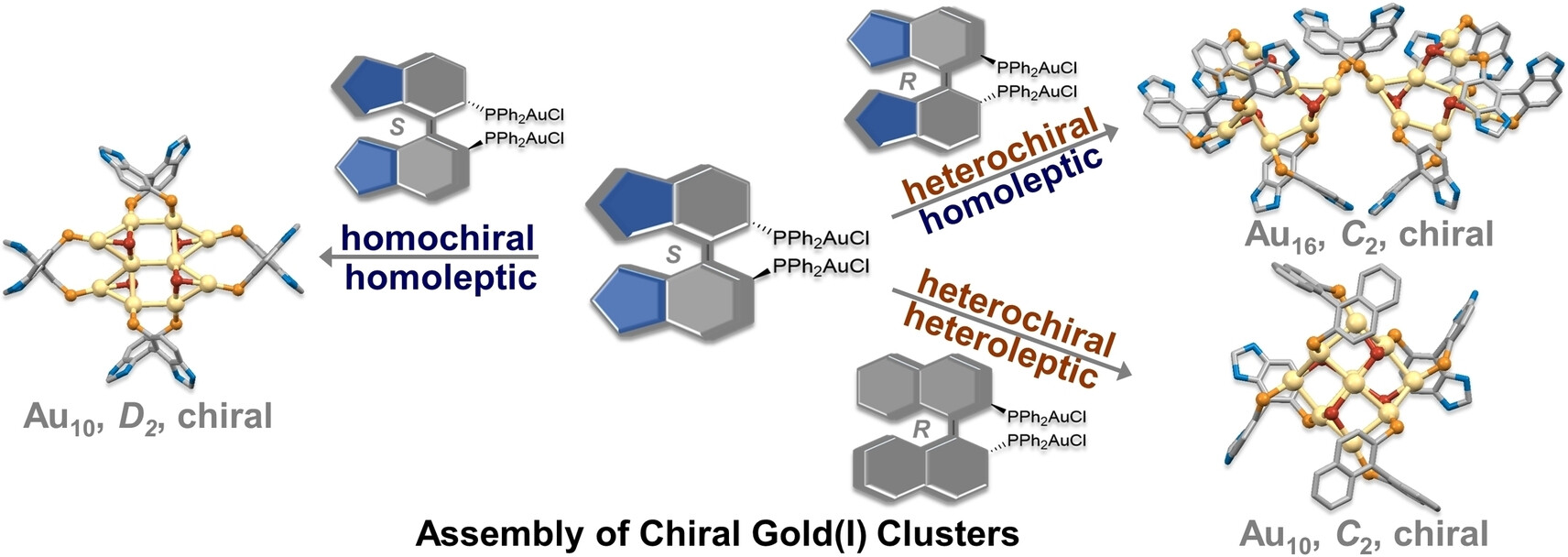
The full potential of the chiral self-sorting in gold(I)-sulfido cluster system has been explored for the first time. Different combinations of axial chiral ligands give rise to distinct chiral gold(I)-sulfido clusters through different types of chiral self-assembly and self-sorting processes, evolving from homochiral assembly to heterochiral self-sorting and the unprecedented heterochiral and heteroleptic self-sorting.
Non-equilibrium Processes
Dynamic Oscillation and Motion of Oil-in-Water Emulsion Droplets
- First Published: 08 November 2023
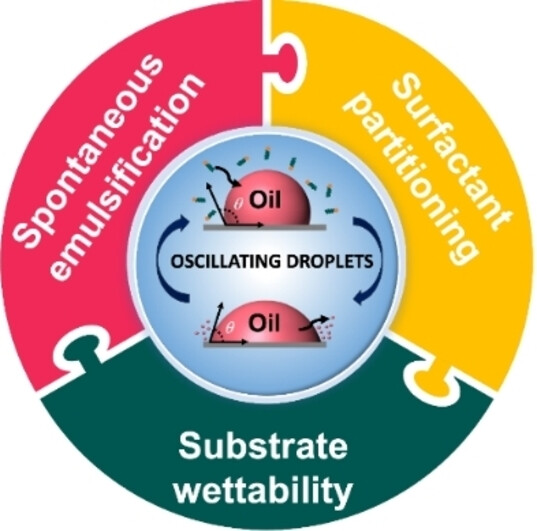
The intersection of surfactant partitioning, spontaneous emulsification, and substrate wettability generates a unique type of motion—droplet oscillation—rarely reported in the literature for oil-in-water emulsion systems. The effect of varying the concentration of the surfactant, substrate properties, and the chemical nature of the oil and surfactant on the oscillating droplets was studied.
Seawater Splitting
Piezocatalytic H2O2 Generation
Triggering Dual Two-electron Pathway for H2O2 Generation by Multiple [Bi−O]n Interlayers in Ultrathin Bi12O17Cl2 towards Efficient Piezo-self-Fenton Catalysis
- First Published: 10 December 2023
![Triggering Dual Two-electron Pathway for H2O2 Generation by Multiple [Bi−O]n Interlayers in Ultrathin Bi12O17Cl2 towards Efficient Piezo-self-Fenton Catalysis](/cms/asset/d0899bf9-e3f3-436b-bd14-a141632539be/anie202316410-toc-0001-m.jpg)
A Bi12O17Cl2 piezo-catalyst was prepared with peculiar [Bi3O4.25] layers. The existence of [Bi3O4.25] not only serves as active sites but also satisfies energy band structure for 2e− ORR and 2e− WOR, realizing the dual pathway for adequate H2O2 synthesis. Expectedly, the constructed Bi12O17Cl2-PESF emerges superior degradation activity for pollutants attributed to sufficient use of in situ produced H2O2 to abundant ⋅OH.
Copper Catalysis
Stereoselective Copper-Catalyzed Olefination of Imines
- First Published: 15 December 2023

A new look at catalytic Wittig-type olefinations. We explored the use of transition metal catalysis to form ylide equivalents from readily available starting materials leading to the development of a highly E-selective copper-catalyzed olefination of imines with alkenyl boronate esters as coupling partners.
Mass Spectrometry
Direct Analysis of Complex Reaction Mixtures: Formose Reaction
- First Published: 15 December 2023
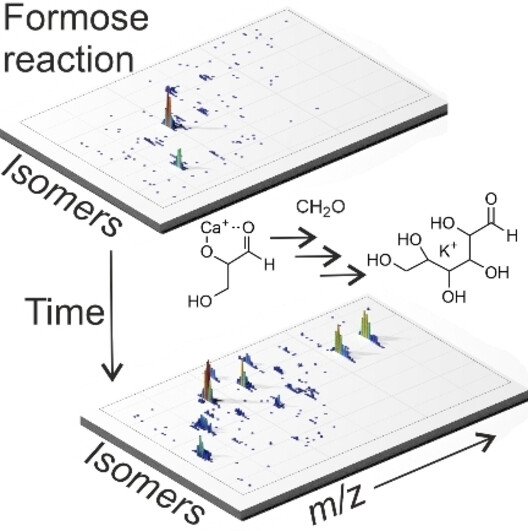
Online monitoring of formose reaction by ion-mobility-separation mass-spectrometry reveals the growth of the size and complexity of sugar molecules. Chemometrics analysis identified the key reaction mixture components and their contribution to the dynamic reaction changes. The results allowed the reconstruction of the reaction networks and analysis of the kinetics of early steps of formose reaction.
C-H Activation | Hot Paper
Asymmetric Ruthenium-Catalyzed C−H Activation by a Versatile Chiral-Amide-Directing Strategy
- First Published: 15 December 2023
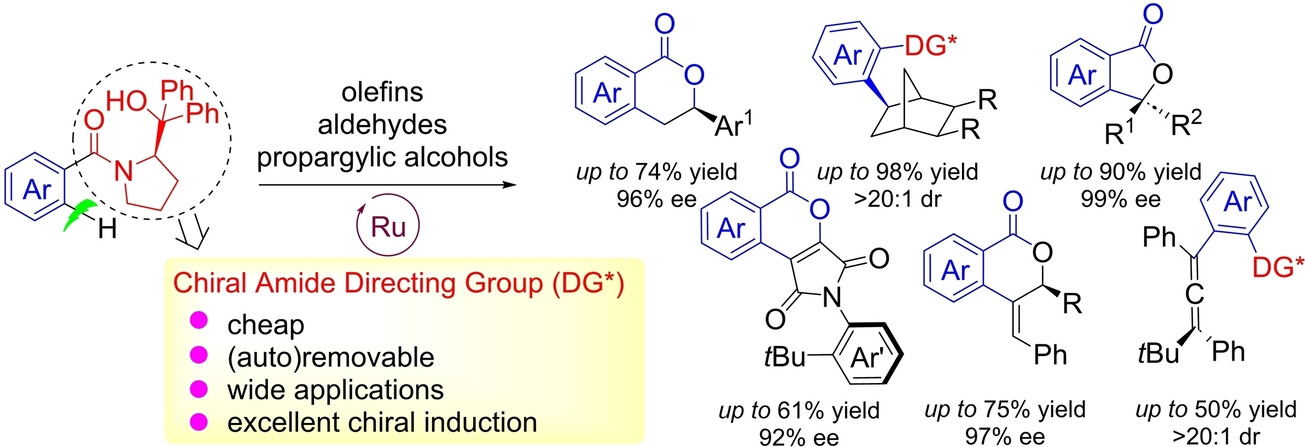
A versatile chiral amide directing group has been studied in the context of the ruthenium(II)-catalyzed asymmetric C−H activation. Six transformations have been achieved, affording a series of valuable chiral products. With this tool, concise syntheses of many natural products and biologically active compounds (e.g., Montroumarin, Cyclosporone E, Cyclosporone Q, Concentricolide, Chuangxinol, and Eleutherol) were accomplished.
Batteries
Manipulated Fluoro-Ether Derived Nucleophilic Decomposition Products for Mitigating Polarization-Induced Capacity Loss in Li-Rich Layered Cathode
- First Published: 20 December 2023
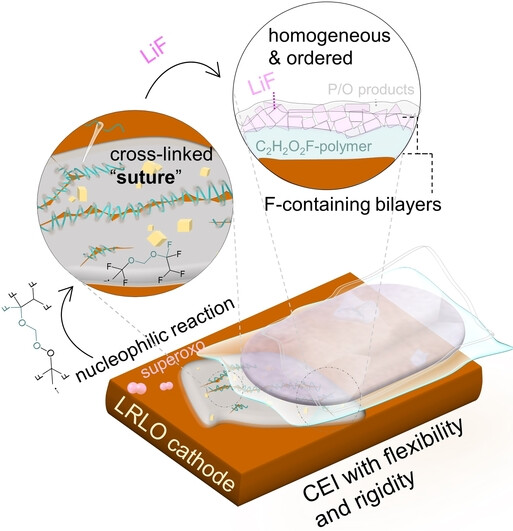
The superior crosslinked products derived from HFE decomposition via nucleophilic O species attack serve as valuable sutures. They prevent fragmented substances from escaping CEI construction, providing an excellent foundation for the homogeneous deposition of LiF related species. Consequently, an effective CEI with both rigidity and flexibility is established, which reduces cell polarization, achieves long-lasting electrochemical performance.
Nanocatalytic Medicine | Very Important Paper
Catechol-Isolated Atomically Dispersed Nanocatalysts for Self-Motivated Cocatalytic Tumor Therapy
- First Published: 14 December 2023
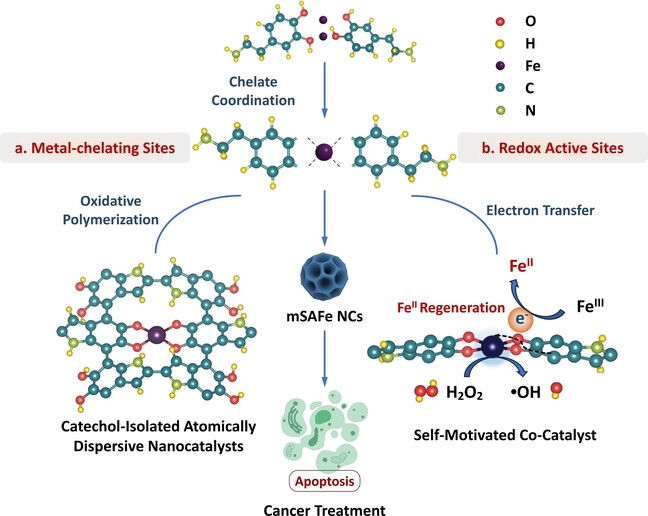
Catechol-isolated mesoporous single iron atomic nanocatalysts (mSAFe NCs) with ligand-field-effect-promoted cocatalytic Fenton catalysis have been constructed. The catechols from dopamine serve as both an iron coordination site for atomic isolation and a reductive ligand to generate a field-effect-based cocatalytic system that instantly reduces FeIII species to FeII species within the mSAFe NCs, thereby promoting in vivo Fenton catalytic effects against tumors.
Chiral Nanostructures
Pathway-Dependent Self-Assembly for Control over Helical Nanostructures and Topochemical Photopolymerization
- First Published: 20 December 2023
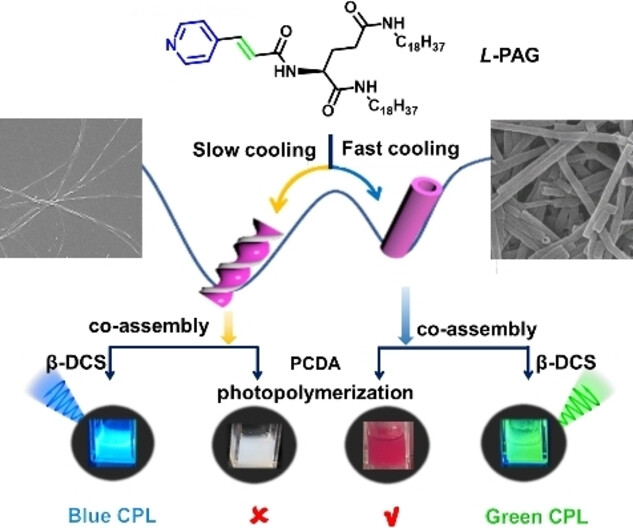
Pathway-dependent supramolecular assemblies from a rationally designed glutamide derivative were found, which formed distinct chiral nanotwist and nanotube depending on the cooling rate. Pathway-dependent self-assembly showed also the ability to control over the guest molecules with emergent blue or green circularly polarized luminescence and topochemical polymerization.
Electrocatalytic O2 Evolution
Rapid Surface Reconstruction of Pentlandite by High-Spin State Iron for Efficient Oxygen Evolution Reaction
- First Published: 27 December 2023
White Phosphorus
Cobalt-Mediated [3+1] Fragmentation of White Phosphorus: Access to Acylcyanophosphanides
- First Published: 07 December 2023
![Cobalt-Mediated [3+1] Fragmentation of White Phosphorus: Access to Acylcyanophosphanides](/cms/asset/bf73a44f-78e5-4895-83e9-6da8a9e3350f/anie202317170-toc-0001-m.jpg)
White phosphorus (P4) can be selectively activated and functionalized via low-valent cobalt complexes. Subsequent treatment of the acylated P4 ligands with cyanide induces a rare [3+1] fragmentation and yields cyanophosphanides (P1) and triphosphido cobaltate (P3). Additional experiments with neutral cyanide or isocyanide provide insight into a plausible fragmentation mechanism and allow the isolation of potential intermediates.
Organic Chemistry
Hydrated [3+2] Cyclotelomerization of Butafulvenes to Create Multiple Contiguous Fully Substituted Carbon Centers
- First Published: 17 December 2023
Aqueous Zn Batteries
Weak Solvation Effect Induced Optimal Interfacial Chemistry Enables Highly Durable Zn Anodes for Aqueous Zn-Ion Batteries
- First Published: 20 December 2023

An electrolyte with weak solvation effect is rationally developed for aqueous Zn ion batteries (AZIBs). Benefiting from the reduced solvated H2O, boosted desolvation kinetics and in situ formed solid electrolyte interface (SEI) layer, Zn anode cycled in this electrolyte can deliver enhanced cycling stability.
Nanoclusters
Modulation of Singlet-Triplet Gap in Atomically Precise Silver Cluster-Assembled Material
- First Published: 11 December 2023
Actinides
Two-Electron Redox Reactivity of Thorium Supported by Redox-Active Tripodal Frameworks
- First Published: 15 December 2023
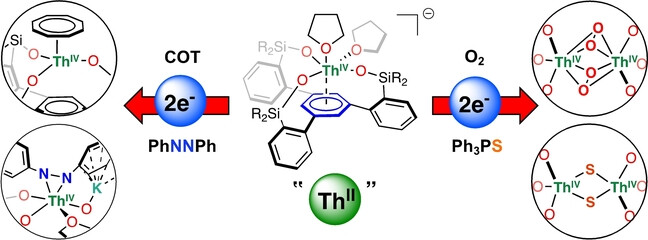
Two electrons can be stored in the arene anchor of robust tripodal siloxide frameworks by chemical reduction of their Th(IV) complexes. The two electrons become available at the metal center for the controlled two-electron reduction of a broad range of substrates (N2O, COT, CHT, Ph2N2, Ph3PS and O2) while the ligand framework is retained in its original form.
Chemical Biology | Hot Paper
Selenium-Based Catalytic Scavengers for Concurrent Scavenging of H2S and Reactive Oxygen Species
- First Published: 15 December 2023
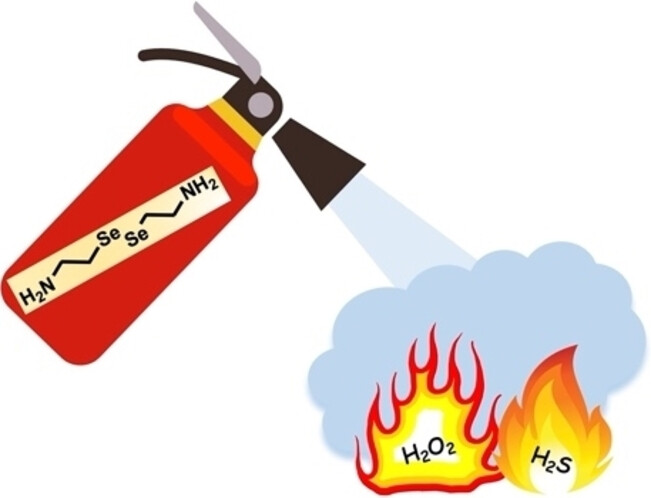
H2S overproduction is linked to various disease states while chemical tools that can precisely downregulate H2S are still lacking. In this work, selenoxide-containing compounds were found to be potent H2S scavengers with promising antidotal effects for H2S poisoning. Several diselenides were further developed as catalytic scavengers for both H2S and H2O2.
Electrocatalysis | Hot Paper
Crystalline Dual-Porous Covalent Triazine Frameworks as a New Platform for Efficient Electrocatalysis
- First Published: 22 December 2023
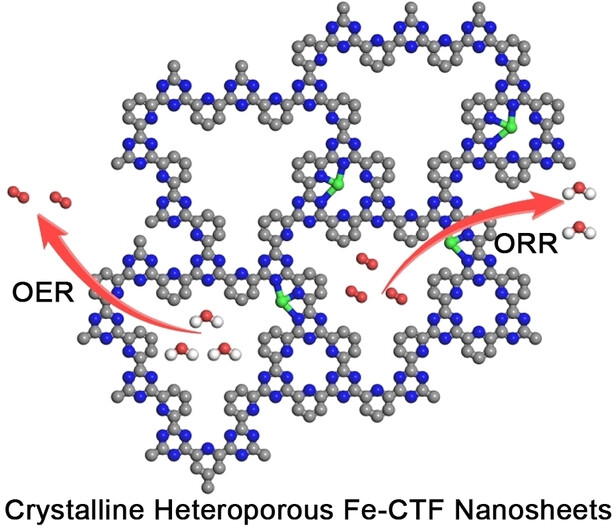
Crystalline dual-porous pyridine-based CTF with in situ generated Fe-N3 single-atom active sites has been synthesized for the first time. Benefiting from the unique structure of Fe-N3 and the dynamic reversible microenvironment of metal active centers, few-layer Fe-CTF nanosheets exhibit remarkable electrocatalytic and Zn-air battery performance.
Polymer Chemistry
Using Redox-Switchable Polymerization Catalysis to Synthesize a Chemically Recyclable Thermoplastic Elastomer
- First Published: 02 January 2024

Triblock copolymers containing poly(L-lactic acid) hard blocks and poly(tetrahydrofuran-co-cyclohexene oxide) soft blocks were synthesized using redox-switchable catalysis. The polymers demonstrated improved flexibility and mechanical properties similar to thermoplastic elastomers and underwent depolymerization under reactive distillation using Lewis acid catalysts, showing the material can be chemically recycled for a circular plastics economy.
Na-S Batteries | Hot Paper
Binary Atomic Sites Enable a Confined Bidirectional Tandem Electrocatalytic Sulfur Conversion for Low-Temperature All-Solid-State Na−S Batteries
- First Published: 20 December 2023
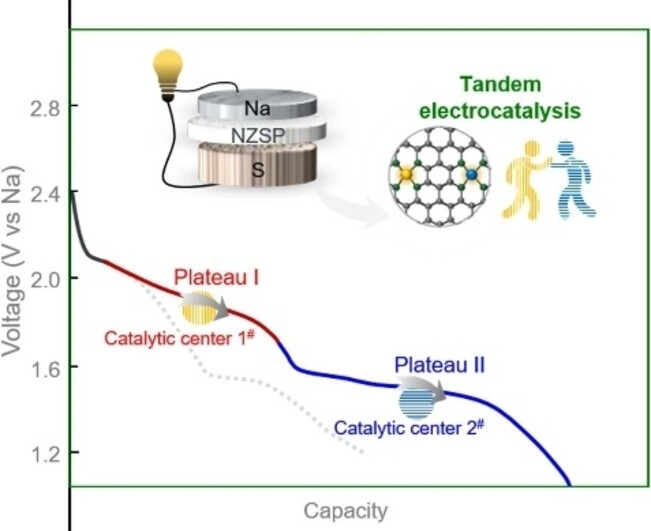
The bifunctional hollow sulfur matrix consisting binary atomically dispersed MnN4 and CoN4 hotspots was fabricated. And the catalytic matrix facilitated confined tandem electrocatalysis effects render the successive reversible conversion of both long- and short-chain polysulfide intermediators and mitigate the cathodic passivation within the Na3Zr2Si2PO12 ceramic membrane architectured solid-state Na−S cells.
Anti-inflammatory Drugs
A Breast Cancer Stem Active Cobalt(III)-Cyclam Complex Containing Flufenamic Acid with Immunogenic Potential
- First Published: 08 December 2023
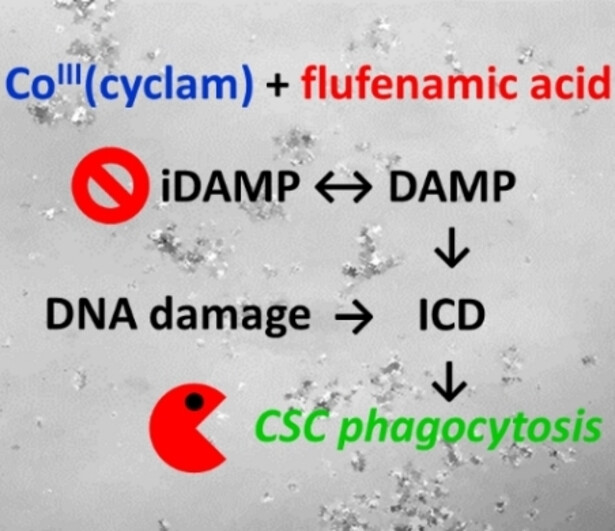
Here we report the first investigation into the cytotoxic and immunogenic potential of a cobalt complex within the context of anti-cancer stem cell (CSC) drug discovery. The cobalt complex is able to deliver flufenamic acid to CSCs, which perturbs the inhibitory damage-associated molecular pattern axis and promotes immunogenic cell death. This subsequently leads to the phagocytosis of CSCs by macrophages.
Self-Assembly
Adjusting the Architecture of Heptagonal Metallo-Macrocycles by Embedding Metal Nodes into the Backbone
- First Published: 12 December 2023
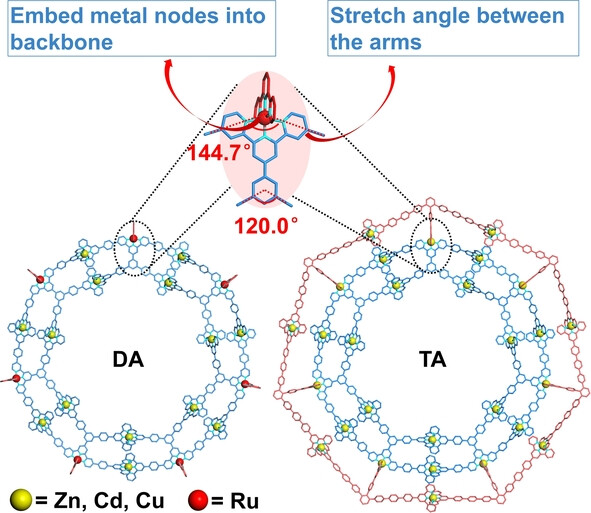
Two giant metallo-macrocycles with double-layer and triple-layer concentric heptagonal structures (DA and TA, respectively) have been successfully assembled by embedding coordination sites in the ligand backbone. The angle between the two arms at position 4 of the central terpyridine (tpy) units increased after complexation with metal ions, leading to precise control over the topology.
CO2 Conversion | Hot Paper
Perfluoroalkyl-Decorated Noble-Metal-Free MOFs for the Highly Efficient One-Pot Four-Component Coupling between Aldehydes, Amines, Alkynes, and Flue Gas CO2
- First Published: 20 December 2023
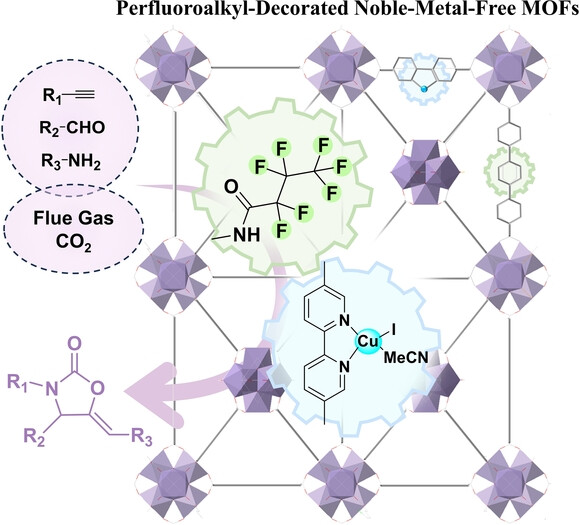
A series of perfluoroalkyl-decorated noble-metal-free metal–organic frameworks [PCN-(BPY-CuI)-(TPDC-Fx), x=3, 5, 7, 11] are rationally fabricated through the stepwise solvent-assisted linker installation, post-synthetic fluorination and metalation, which showed excellent performance in catalyzing the one-pot four-component tandem reaction between alkyne, aldehyde, amine and flue gas CO2 for the facile preparation of 2-oxazolidinones.
CO2 Reduction | Very Important Paper
Boosting Electrocatalytic Carbon Dioxide Reduction via Self-Relaxation of Asymmetric Coordination in Fe-Based Single Atom Catalyst
- First Published: 15 December 2023
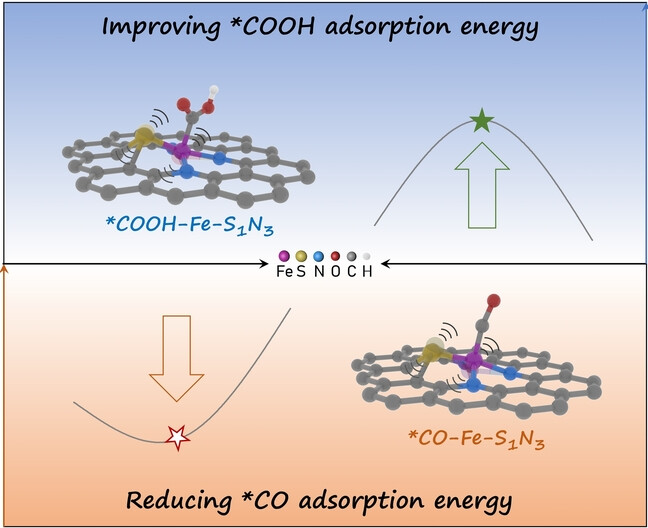
We implemented an asymmetric coordination Fe−S1N3 SAC with significant geometric distortion. The Fe−S1N3 sites demonstrate distinctive self-relaxation behavior in response to different adsorption intermediates during the CO2RR process. The dynamic change in bond length enabled independent regulation of the *COOH and *CO intermediates adsorption energies, effectively breaking the linear scale relationship and enhancing the intrinsic activity.
Pillararenes | Hot Paper
Friedel–Crafts Acylation for Accessing Multi-Bridge-Functionalized Large Pillar[n]arenes
- First Published: 18 December 2023
![Friedel–Crafts Acylation for Accessing Multi-Bridge-Functionalized Large Pillar[n]arenes](/cms/asset/a4e90c14-7e70-45ca-8f71-153e726766de/anie202318268-toc-0001-m.jpg)
Different lateral functionalized pillar[n]arenes can be obtained using Friedel–Crafts acylation. The irreversible nature of acylation results in the macrocycles being obtained selectively in terms of ring sizes and functional positions. Further derivatization of the ketones is also possible to afford various laterally modified pillar[n]arenes that cannot be accessed by general Friedel–Crafts alkylation reactions.
Zn-MnO2 Batteries
Revealing the Dominance of the Dissolution-Deposition Mechanism in Aqueous Zn−MnO2 Batteries
- First Published: 20 December 2023
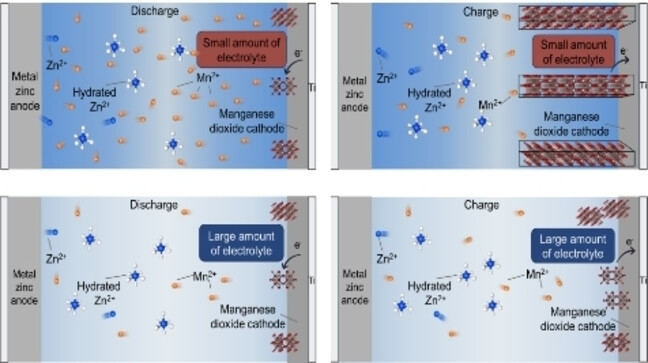
This work pinpointed the cause of the capacity degradation of Zn−MnO2 batteries and established the dominance of the MnO2/Mn2+ dissolution-deposition mechanism. Such a methodology circumvents the complicated characterization methods used in previous studies and provides a universal approach to accurately identify the reaction mechanism of other aqueous batteries.
Fluorescent Probes
Real-Time Live Imaging of Osteoclast Activation via Cathepsin K Activity in Bone Diseases
- First Published: 17 December 2023
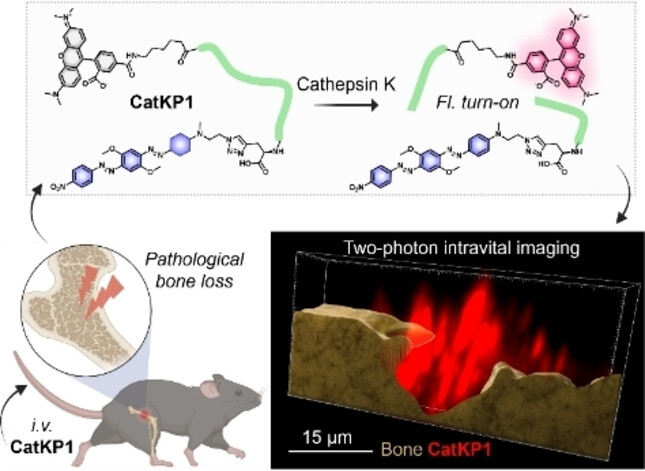
A new two-photon fluorogenic probe, CatKP1, has been developed to detect cathepsin K and enable the real-time monitoring of osteoclast activity in hindlimb long bones during pathologic bone loss. This highlights the importance of CatKP1 as a valuable tool for studying aberrant osteoclast behavior and exploring new therapeutic strategies.
Covalent Organic Frameworks | Hot Paper
Efficient Photosynthesis of Hydrogen Peroxide by Cyano-Containing Covalent Organic Frameworks from Water, Air and Sunlight
- First Published: 27 December 2023
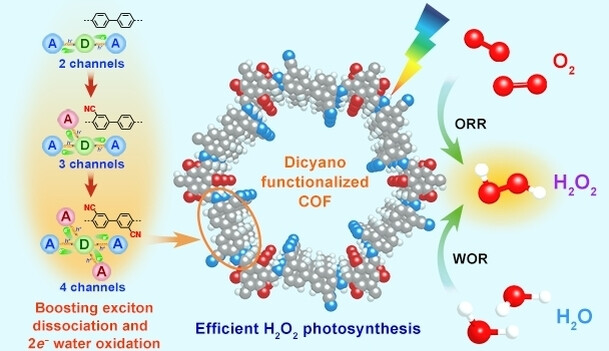
This work not only provides new insights into the design of COFs by regulating the amount of charge transfer channels and enhancing the rate-determining two-electron water oxidation to boost H2O2 photosynthesis, but also paves the way for the practical application of COFs-based photocatalysts in solar-driven synthesis.
Xylene Sensing
Confinement of p-Xylene in the Pores of a Bilanthanide Metal–Organic Framework for Highly Selective Recognition
- First Published: 12 December 2023
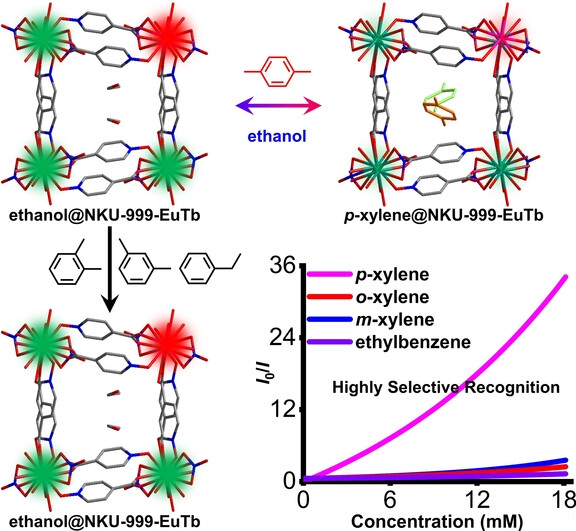
The porosity's significance in metal–organic frameworks (MOFs) has often been overlooked in luminescent sensing applications. A luminescent MOF NKU-999 was synthesized with tailored pores for highly selective and quantitative p-xylene recognition. The sensing mechanism was investigated by single crystal X-ray diffraction and dynamic magnetic susceptibilities.
NH3 Production | Hot Paper
Aqueous Electroreduction of Nitric Oxide to Ammonia at Low Concentration via Vacancy Engineered FeOCl
- First Published: 20 December 2023
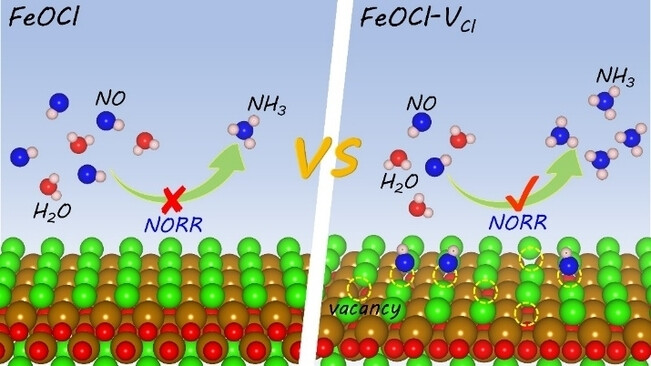
A Cl vacancy strategy results in a lower Fe oxidation state with sharp d-states characteristics to enhance the adsorption and activation of NO, which overcomes the sluggish kinetics of NORR and competitive HER over FeOCl-VCl, especially at low concentrations of NO, and improves the catalytic activity and selectivity towards NORR.
Communications
Soft Matter | Hot Paper
Interfacial Preparation of Polyoxometalate-Based Hybrid Supramolecular Polymers by Orthogonal Self-Assembly
- First Published: 10 November 2023
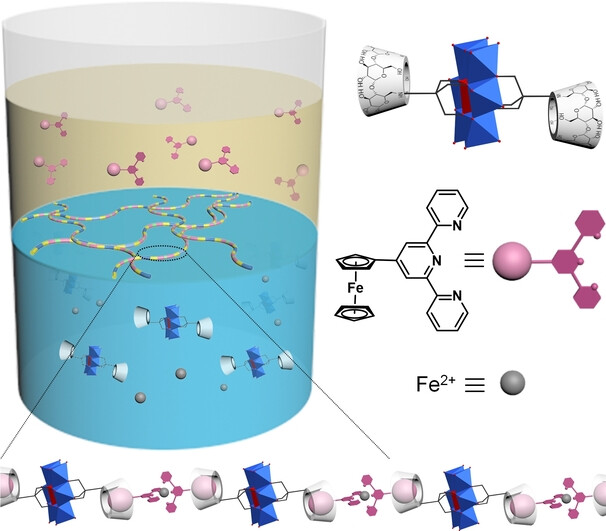
A simple and efficient strategy is developed to prepare polyoxometalate-based hybrid supramolecular polymers (POM-SPs) by interfacial orthogonal self-assembly. Owing to the dynamic nature of noncovalent interactions, POM-SP-based interfacial assemblies with redox or competitive agent responsiveness can be achieved.
Topochemistry
Disproportionation of Co2+ in the Topochemically Reduced Oxide LaSrCoRuO5
- First Published: 12 December 2023
Electrochemistry | Hot Paper
Electrochemical Azidocyanation of Alkenes
- First Published: 31 October 2023

An electrochemical alkene azidocyanation reaction that is compatible with both alkyl and aryl alkenes was developed. The reactions involving aryl alkenes could be obtained with good enantioselectivities by employing a chiral ligand. Notably, this method of alkene difunctionalization employs readily accessible reagents and is distinguished by its demonstrated functional group tolerance.
Analytical Chemistry
Selective Hemin Binding by a Non-G-quadruplex Aptamer with Higher Affinity and Better Peroxidase-like Activity
- First Published: 27 December 2023
Bioimaging | Very Important Paper
Exchangeable Self-Assembled Lanthanide Antennas for PLIM Microscopy
- First Published: 22 November 2023
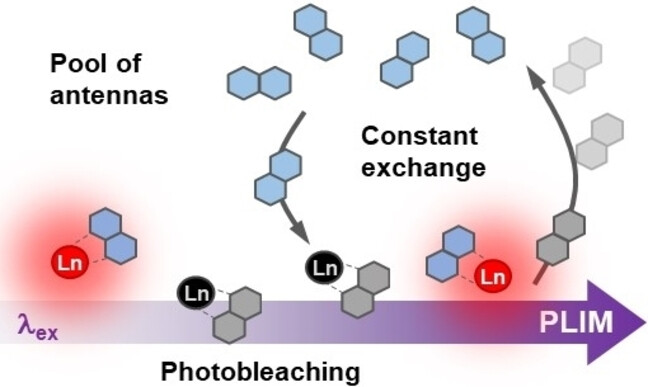
We report a small aqueous-soluble lanthanide antenna (PAnt) specifically designed to dynamically interact with lanthanide ions and act as an exchangeable dye, aiming at mitigating photobleaching in PLIM microscopy in cellulo. Our self-assembled lanthanide complex exhibited an exceptional photostability compared to traditional lanthanide cryptates, marking a significant advance in quantitative PLIM bioimaging.
Nucleic Acids
Diadenosine Tetraphosphate (Ap4A) Serves as a 5′ RNA Cap in Mammalian Cells
- First Published: 07 November 2023
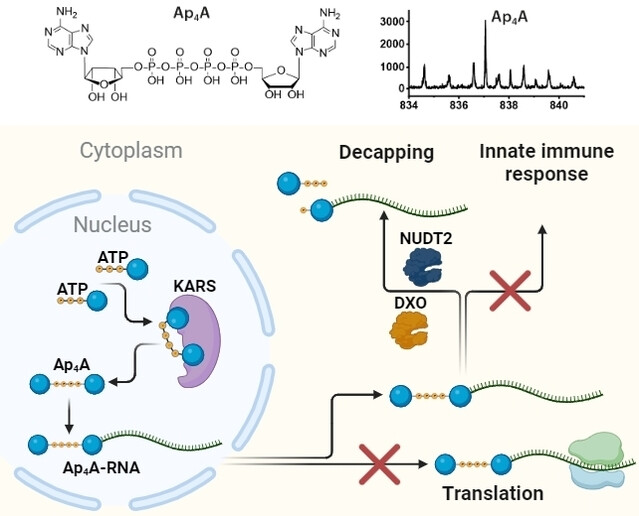
Diadenosine tetraphosphate-RNA (Ap4A-RNA) is found in human and rat cell lines. Its amount is not dependent on the intracellular concentration of Ap4A. Ap4A-RNA is decapped by two enzymes, NUDT2 and DXO. Even though Ap4A-RNA is present in the same fraction as mRNA, it is not translated. However, it is recognized as self RNA by the innate immune system, as it does not elicit an immune response.
Microdroplet Chemistry | Very Important Paper
Superfast Formation of C(sp2)−N, C(sp2)−P, and C(sp2)−S Vinylic Bonds in Water Microdroplets
- First Published: 20 December 2023
Hydrogenases | Hot Paper
Acyl and CO Ligands in the [Fe]-Hydrogenase Cofactor Scramble upon Photolysis
- First Published: 15 December 2023
![Acyl and CO Ligands in the [Fe]-Hydrogenase Cofactor Scramble upon Photolysis](/cms/asset/039fd87d-f8d6-45f2-ad01-2ce0a6fdca9c/anie202316478-toc-0001-m.jpg)
The [Fe]-hydrogenase cofactor contains an acyl- and two CO-ligands. Biosynthesis using stable isotopes demonstrated the formation of the acyl ligand from the carboxy group of the precursor, and MS/MS analysis indicated that the acyl and CO ligands exchanged during photolysis. Time-resolved infrared spectroscopy revealed the presence of an acyl-Fe(CO)3 intermediate during photolysis, which could explain the acyl/CO ligand exchange.
Organocatalysis
Photochemical Deoxygenative Hydroalkylation of Unactivated Alkenes Promoted by a Nucleophilic Organocatalyst
- First Published: 18 December 2023
Photoredox Catalysis
Iridium-Catalyzed Reductive (3+2) Annulation of Lactams Enabling the Rapid Total Synthesis of (±)-Eburnamonine
- First Published: 13 December 2023

A reductive (3+2) annulation of lactams was developed through a sequential process consisting of iridium-catalyzed hydrosilylation of the lactam carbonyl group followed by iridium-catalyzed photoredox coupling with α-bromoacetic acid. The method was successfully applied to the four-step total synthesis of (±)-eburnamonine.
Photochemistry
Photoredox-Catalyzed Generation of Tertiary Anions from Primary Amines via a Radical Polar Crossover
- First Published: 08 January 2024

A deaminative radical-polar crossover strategy generating carbanions is reported. This so called “aza-Reformatsky” reaction leverages the use of redox-active imines and an iridium photocatalyst to generate a wide array of tertiary benzylic, heteroarylbenzylic and α-ester anions, which can be trapped with different electrophiles.
Boron Chemistry
Catalyst-Free Regioselective Diborylation of Aryllithium with Tetra(o-tolyl)diborane(4)
- First Published: 20 December 2023

A catalyst-free highly regioselective and efficient o-diborylation of aryllithium with tetra(o-tolyl)diborane(4) has been developed, leading to a family of o-diborylarenes in very good yields under mild reaction conditions. Density functional theory calculations reveal that an aromatic nucleophilic C(sp2)−H substitution pathway may be involved.
Lewis Base Catalysis | Hot Paper
Enantioselective Construction of Eight-Membered N-Heterocycles from Simple 1,3-Dienes via Pd(0) Lewis Base Catalysis
- First Published: 15 December 2023

An unprecedented (4+4) cycloaddition of simple 1,3-dienes with azadienes is achieved by π-Lewis basic palladium (0) catalysis, delivering benzofuran-fused eight-membered heterocycles in high efficiency, regio- and enantioselectivities. Highly diastereoselective derivatizations of the resultant eight-membered cyclic alkenes provide a facile access to diverse fused polycyclic compounds in excellent efficiency.
Photochemistry
Decarboxylative Radical Sulfilimination via Photoredox, Copper, and Brønsted Base Catalysis
- First Published: 21 December 2023

We report the protocol for decarboxylative radical sulfilimination reactions between sulfenamides and N-hydroxyphthalimide esters of primary, secondary, and tertiary alkyl carboxylic acids, which were achieved via a combination of photoredox, copper, and Brønsted base catalysis. The mild, operationally simple reaction has good functional group compatibility. Our findings provide a Brønsted base activation strategy for metallaphotoredox catalysis.
Inoganic Materials | Hot Paper
In Situ Chiral Template Approach to Synthesize Homochiral Lead Iodides for Second-Harmonic Generation
- First Published: 21 December 2023
Supramolecular Chemistry | Hot Paper
Selective Synthesis and Functionalization of an Acyclic Methylene-Bridged-Arene Trimer in a Cage
- First Published: 20 December 2023

Precise control of repeating reactions to form oligomeric compounds is challenging because such reactions are controlled only statistically. Here, we show that a coordination cage serves as a nano-reaction vessel in the iteroselective condensation of a simple aromatic compound and formaldehyde to form a methylene-bridged arene trimer. The confinement effect for the kinetic protection is also demonstrated by the subsequent iodination of the trimer within the cage.




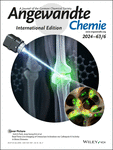


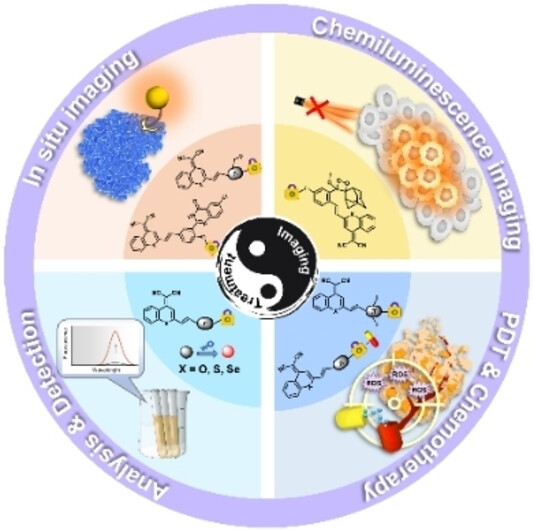
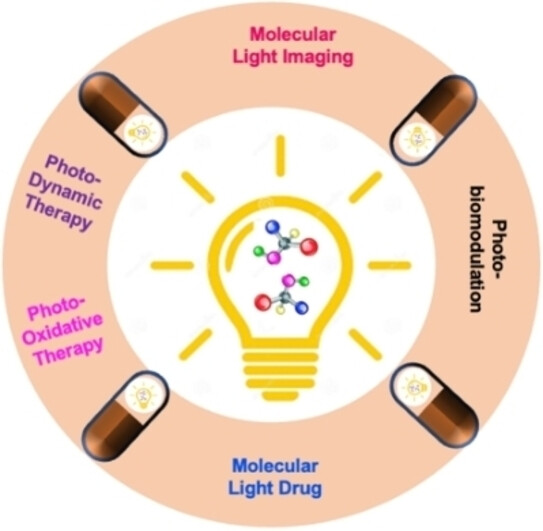
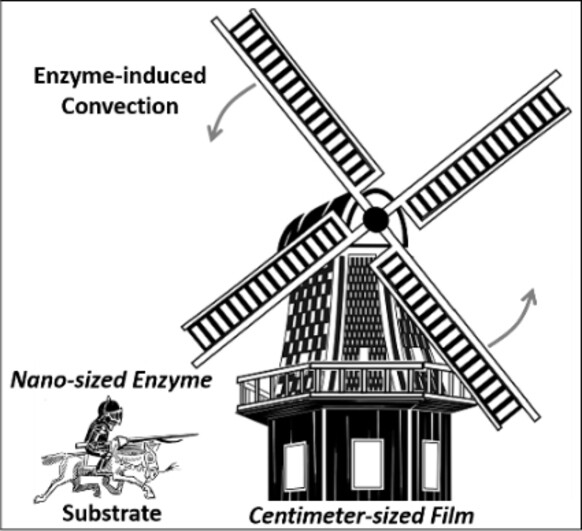
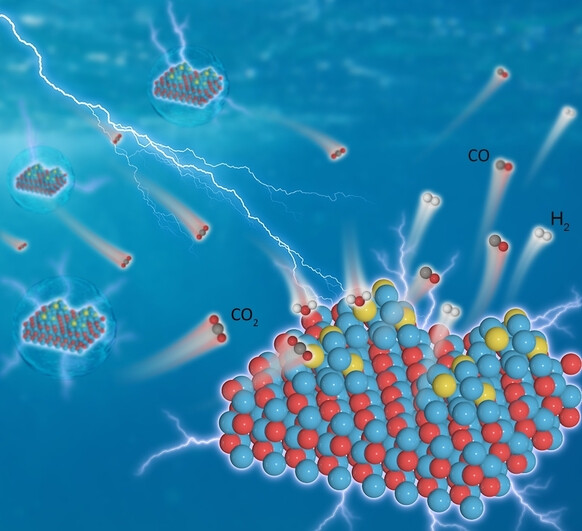


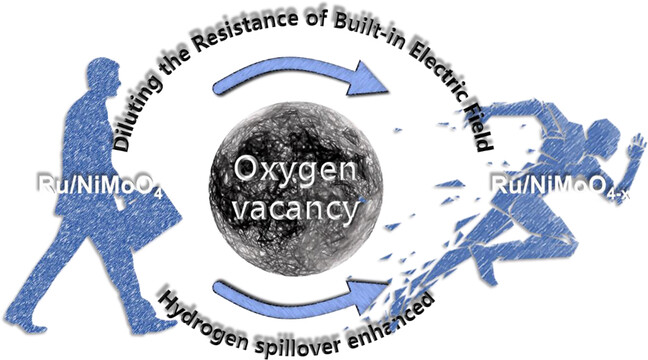
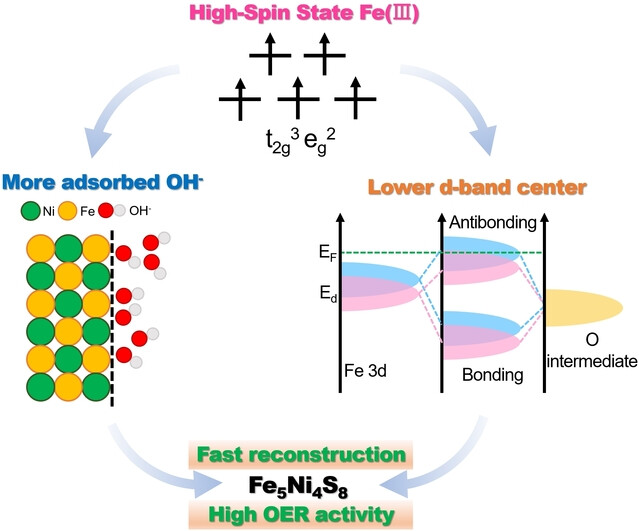
![Hydrated [3+2] Cyclotelomerization of Butafulvenes to Create Multiple Contiguous Fully Substituted Carbon Centers](/cms/asset/c7fa3c56-1d3d-49f1-9b2d-cec4d3c84a1f/anie202317299-toc-0001-m.jpg)
